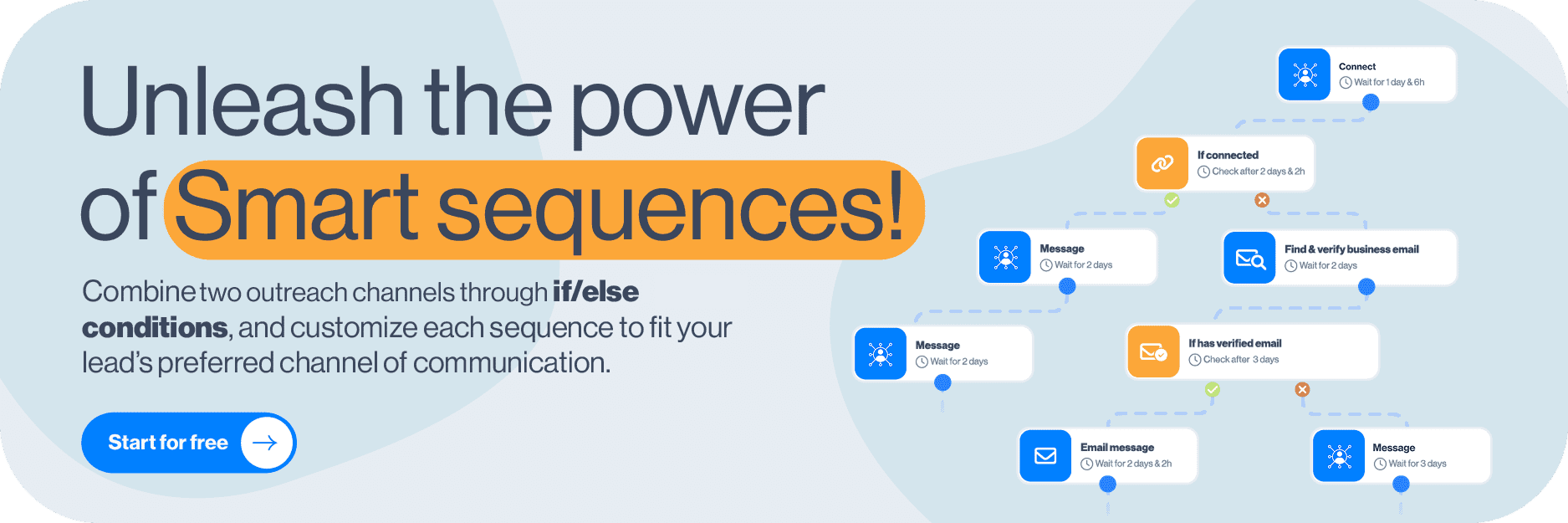Disclaimer: Skylead is not affiliated, endorsed by, or connected with LinkedIn in any way.
When it's time to remove LinkedIn connections, remember to do it discreetly. You may want to remove someone without them knowing, whether for work or to clear up your LinkedIn network.
Fortunately, LinkedIn has ways to do this without causing disturbance. You can block people or remove connections without tipping off the other person.
Below, we’ll discuss a few ways you can try to remove connections from your LinkedIn network. Go through the list and see what methods suit you best!
How do you remove connections from your LinkedIn network? Quick answer
Here's the fastest way to remove LinkedIn connections via the LinkedIn desktop site.
First, go to your LinkedIn homepage and click the My Network tab.
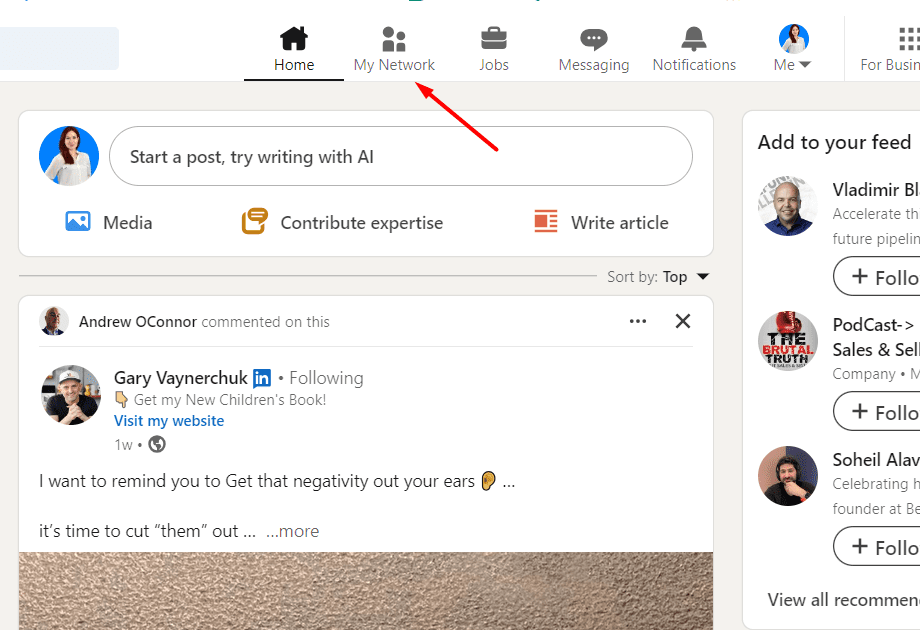
Next, hit Manage my network, select Connections from the left-hand menu.
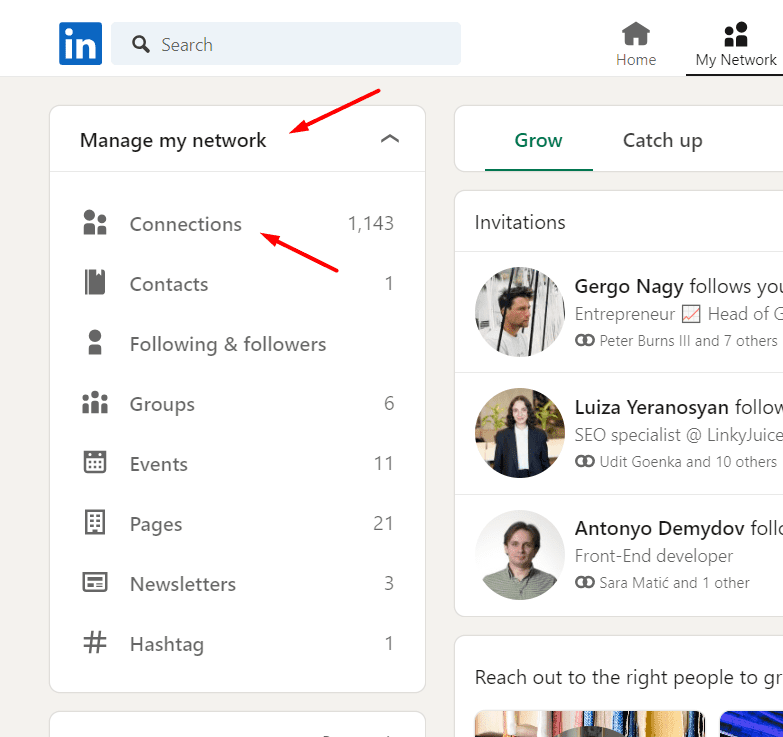
Then scroll through your list of connections, and find the person you want to remove. Open up their Profile page, and click the More option below their LinkedIn name & title info. Lastly select Remove connection from the drop-down list, and confirm your choice.
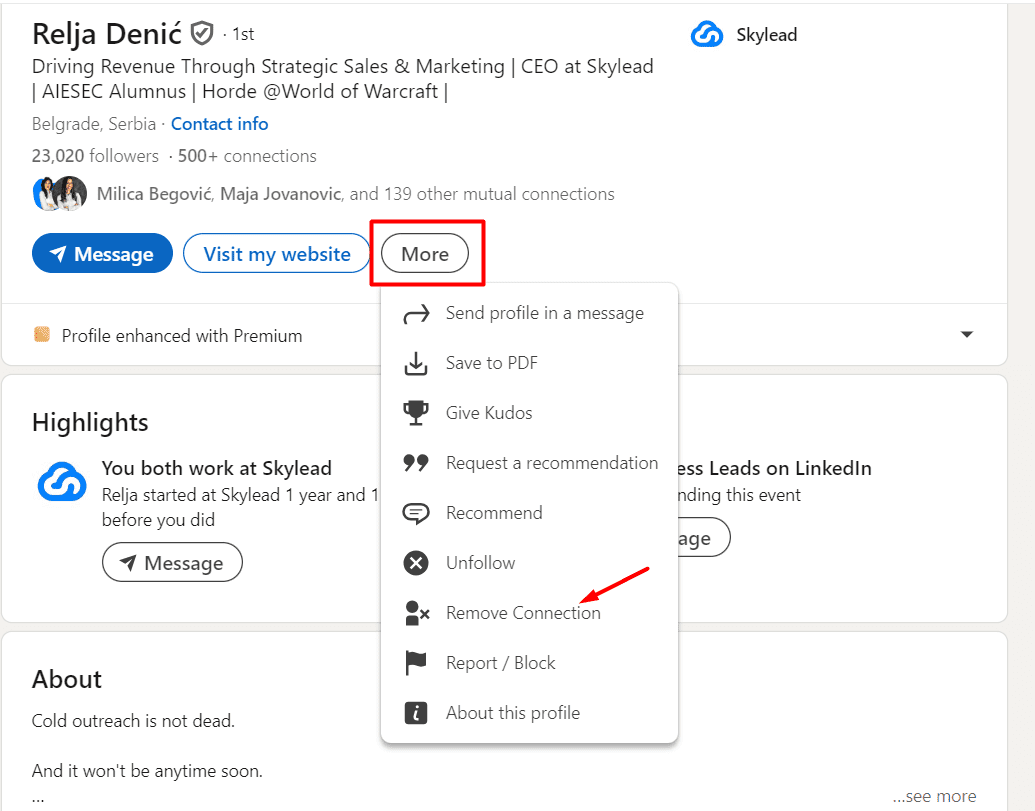
Remove connections on LinkedIn via mobile app (android and IOS)
If you want to remove connections from your LinkedIn network via the mobile app, here’s what you can do.
Firstly, launch the LinkedIn app on your phone or tablet, and tap the “My Network” option from the button menu list.
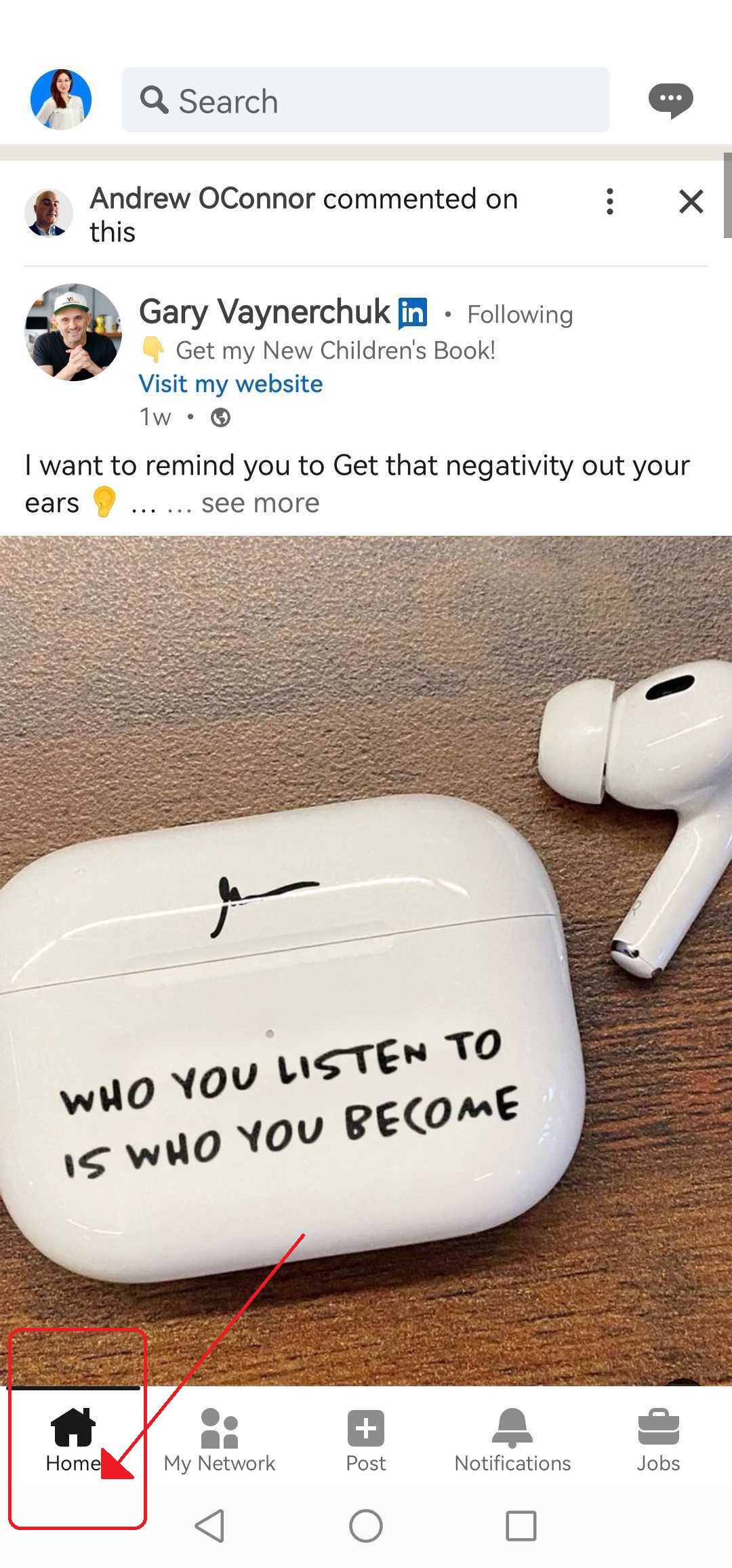
Now, tap on the option titled Manage my network.
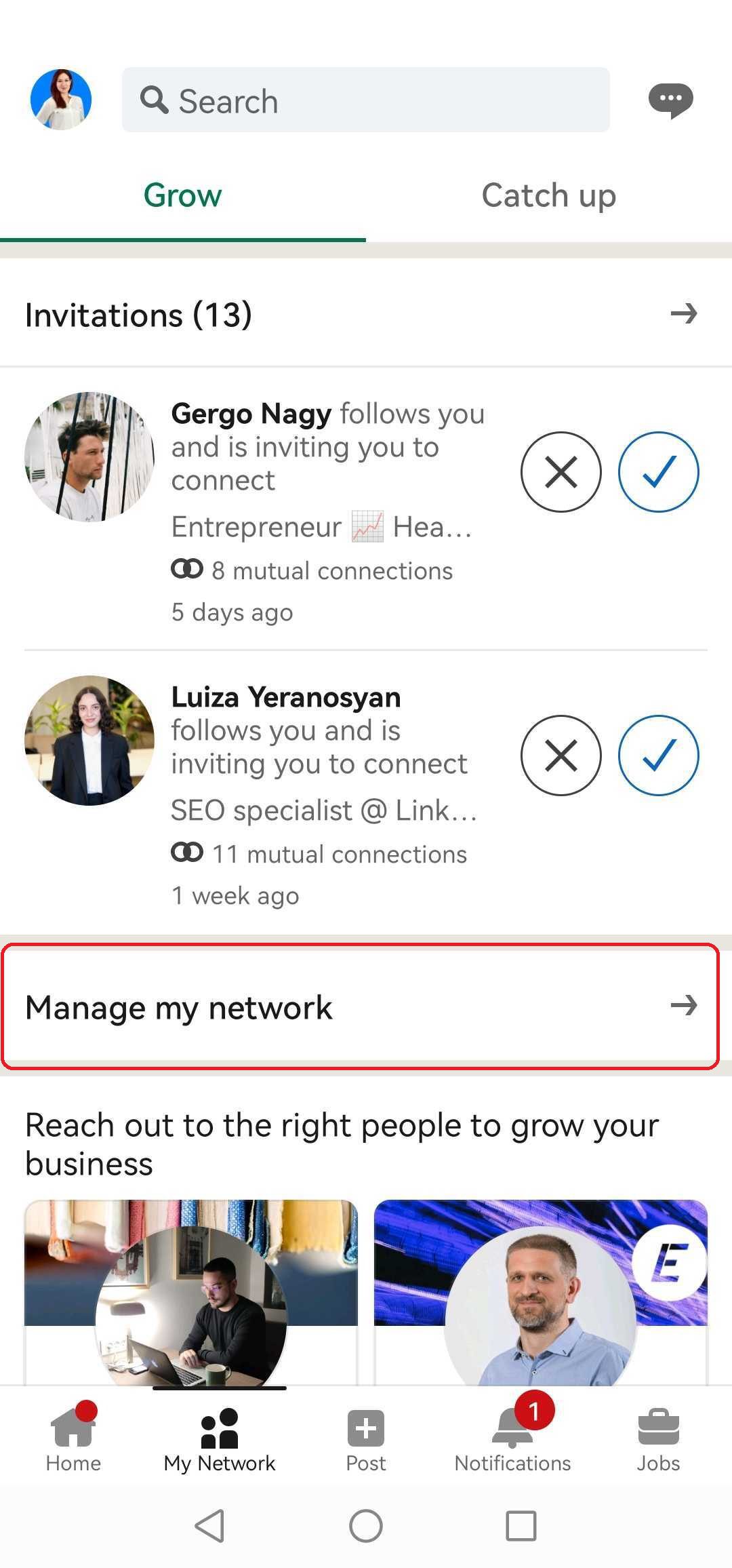
Tap on “Connections, and locate the profile of the connection you want to remove.
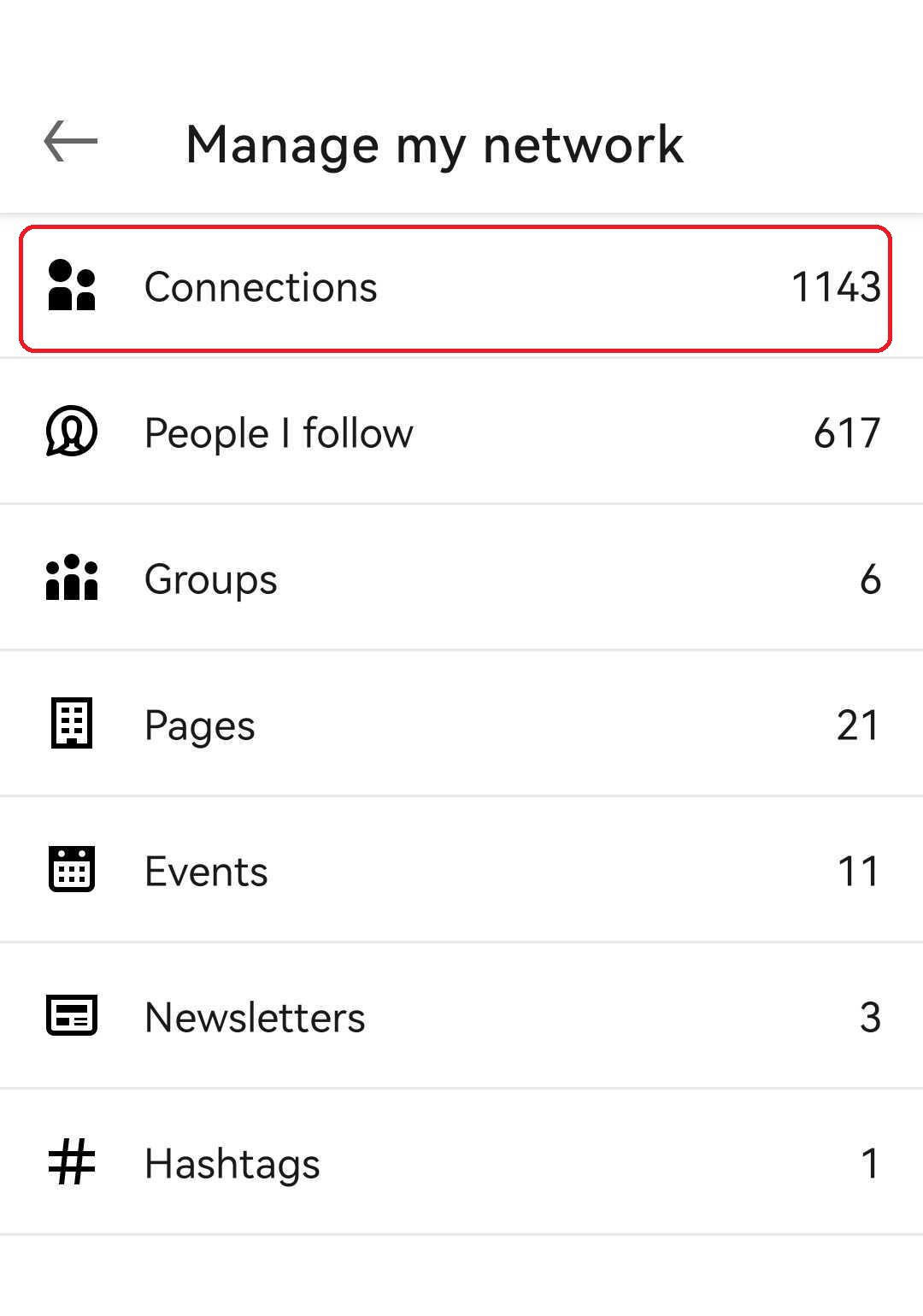
On their profile, tap the "three dots" button next to the message option.
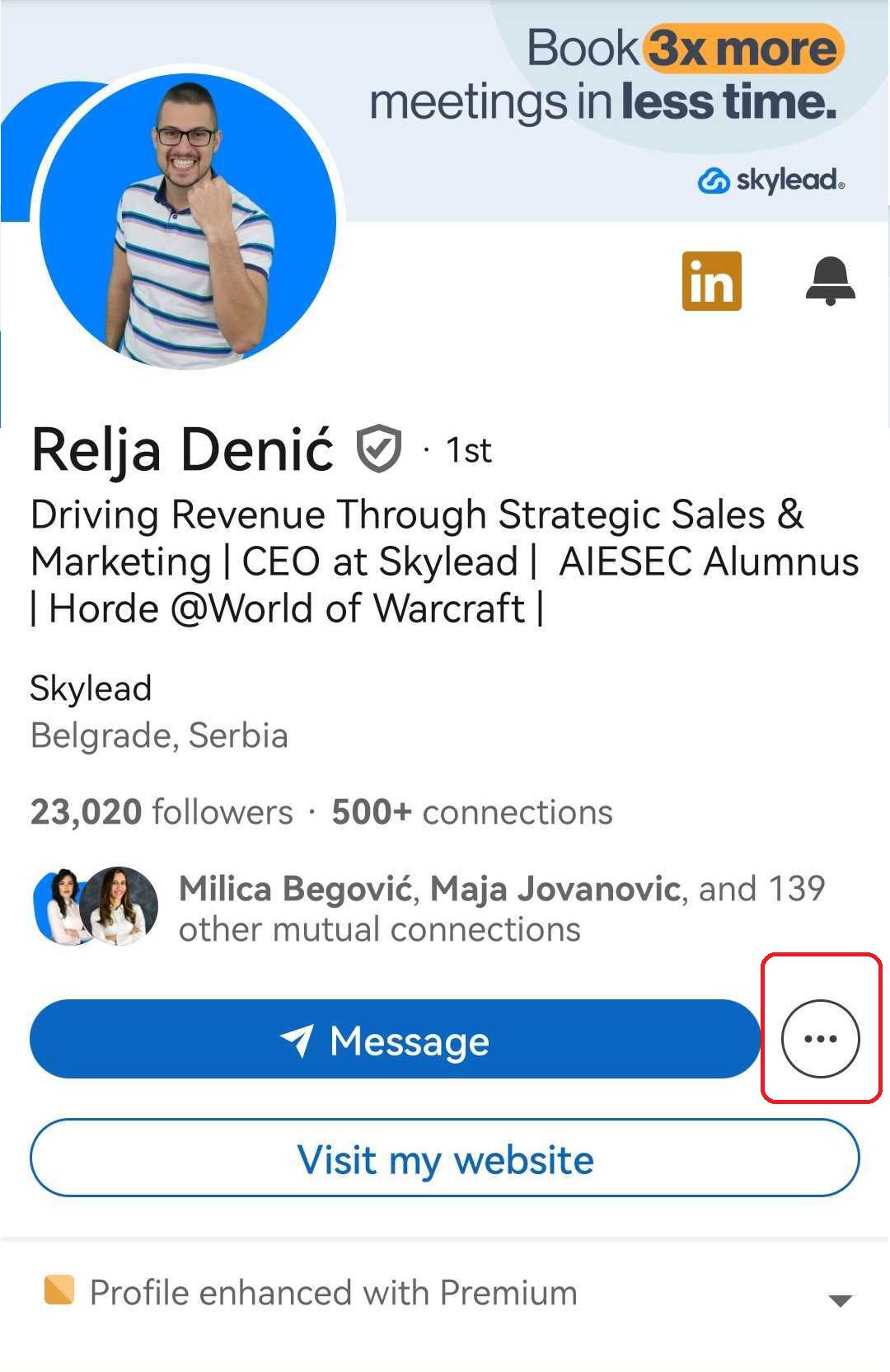
Lastly, select "Remove Connection" from the menu and confirm to complete the removal.
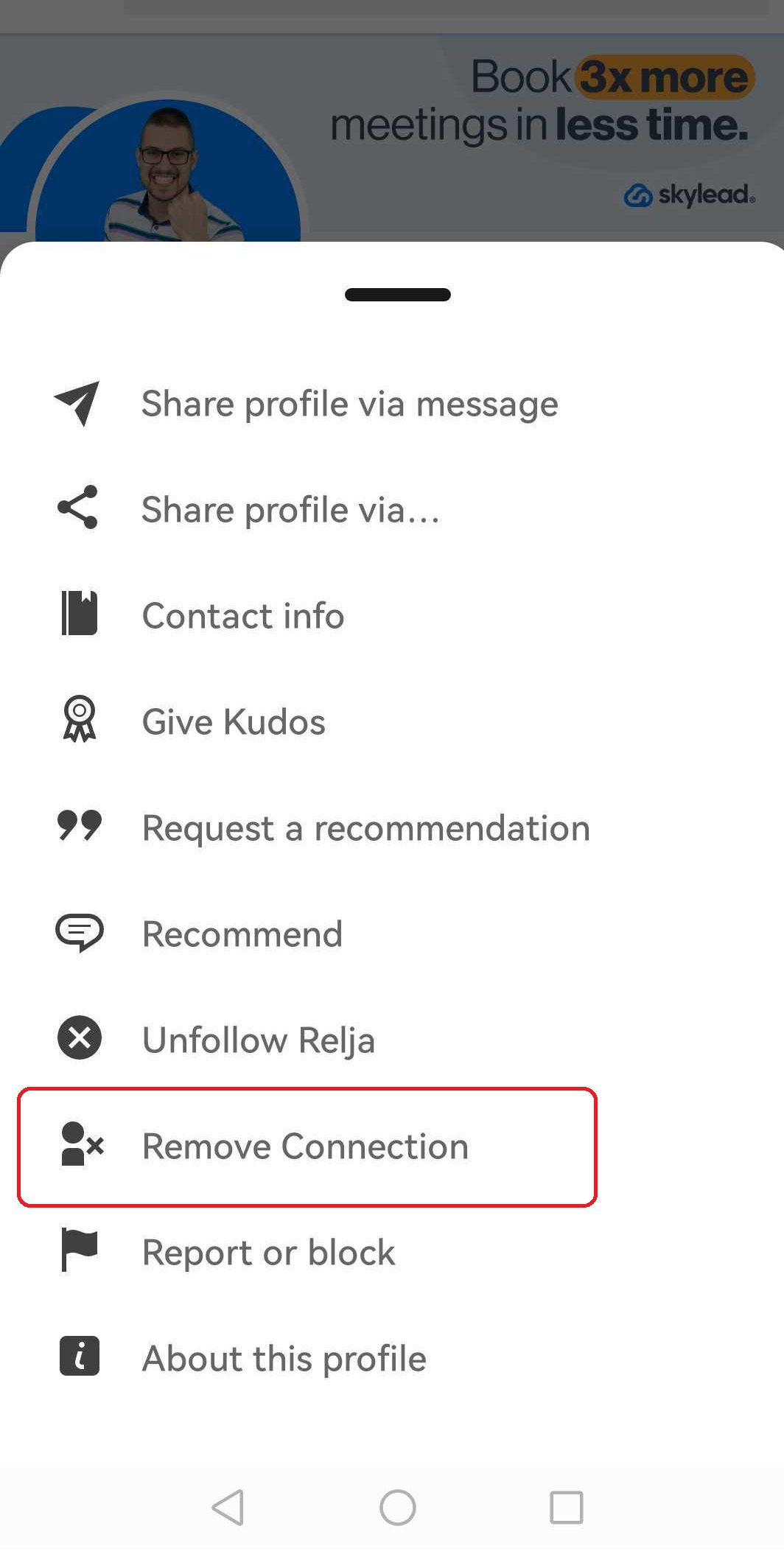
Bonus point: How to remove LinkedIn connections with Skylead?
Are you a sales professional, marketer, recruiter or a business owner that uses LinkedIn for outreach to generate leads? If you are, you can manage your leads using different tools.
For example, Skylead is the all-in-one sales engagement and cold email outreach solution through which you can send outreach messages.
Moreover, you can combine these actions with if/else conditions and create a Smart sequence - a coherent outreach flow that Skylead will follow based on your leads’ behavior.
Lastly, in Skylead you can incorporate email discovery and verification action, to enrich your contacts without breaking an outreach flow. That said, a picture's worth more than a thousand words, so here’s how one smart sequence can look like.
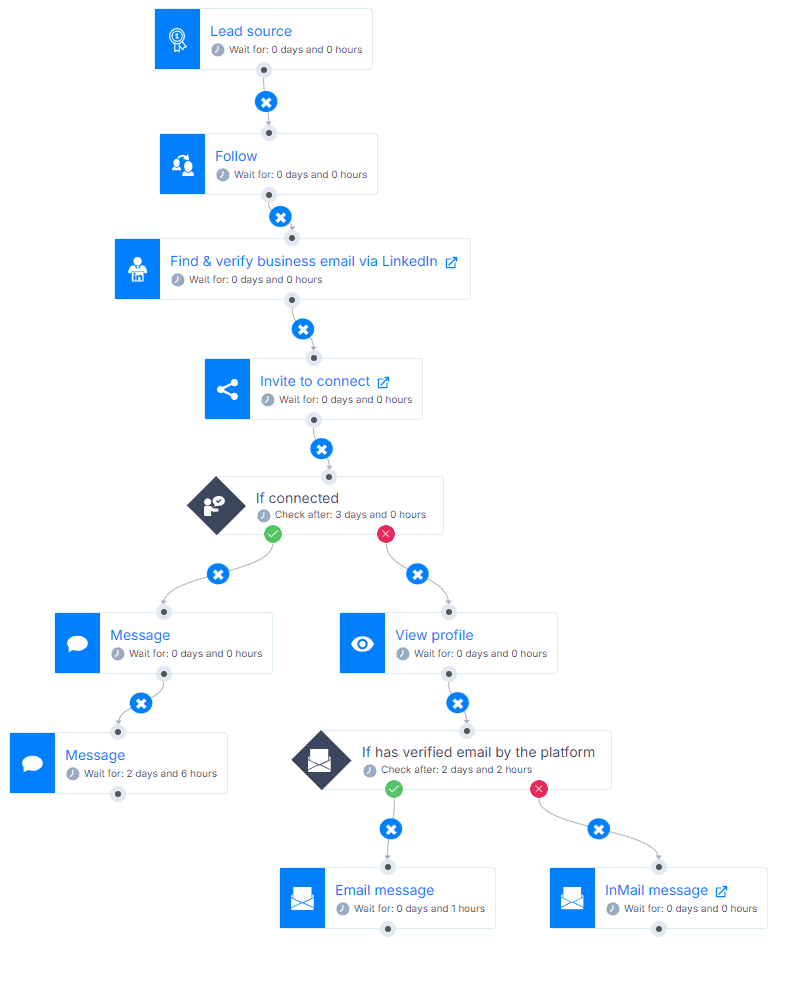
You can also include variables, hyper-personalized images, and GIFs to customize your messages. Thus, significantly increasing your response rates.
And what about managing your leads once they reply? In that case, you can respond to all your messages from Skylead’s Smart inbox. You can save response templates for easier replies and create labels to prioritize leads there.
However, what if (for any reason whatsoever) you want to remove a lead from the connections built via your campaigns? You can either try the method discussed above. Or, you can go to your Skylead’s app interface and directly remove the connection from there.
You can remove your LinkedIn connections using Skylead through two ways.
1# Remove connections on LinkedIn through Skylead’s Leads page
Here’s the step by step process of how you can remove LinkedIn connections via Skylead’s Leads page.
Go to the Leads page on Skylead's platform, and click the name of the lead whose connection you want to remove.
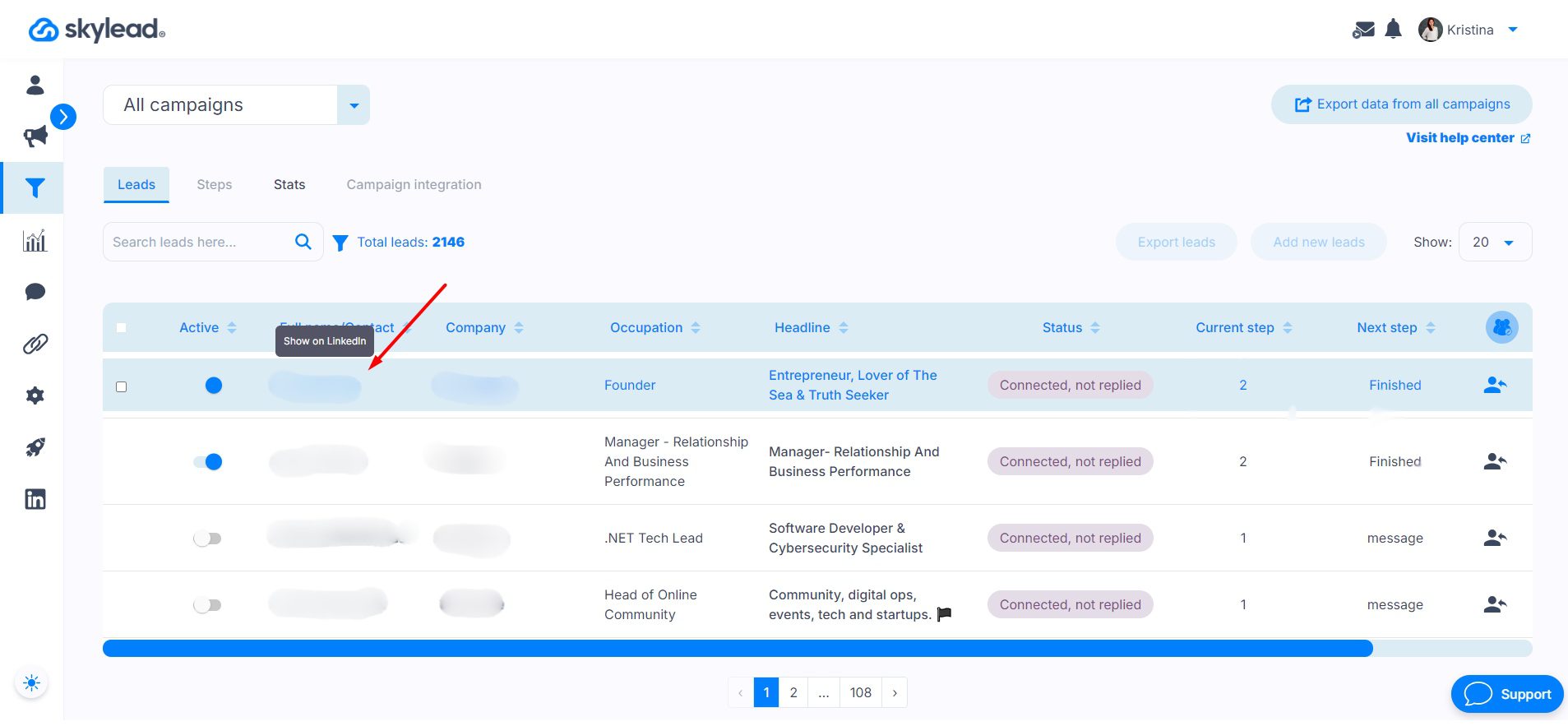
Next, on the LinkedIn profile, hit the More button next to the Message button. Lastly, locate and Remove connection from the dropdown menu and confirm the action.
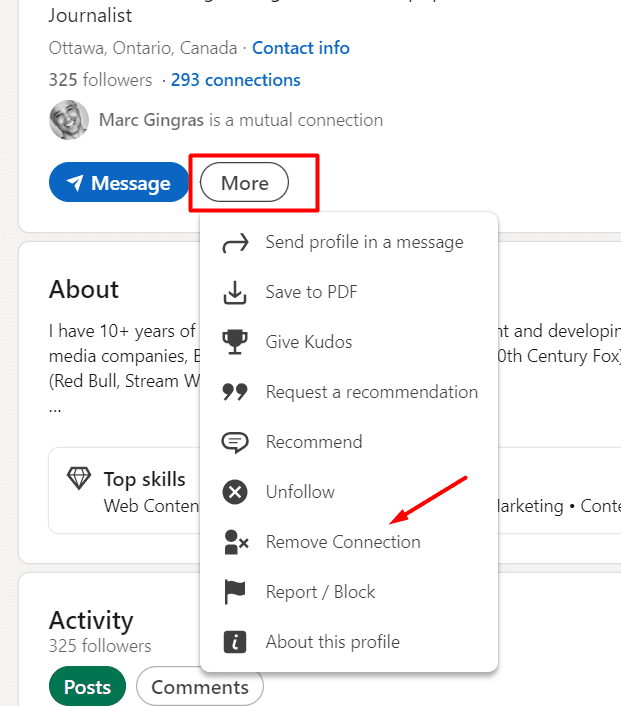
2# Remove connections on LinkedIn through Skylead’s Smart inbox
Instead of manually going through your LinkedIn or Sales Navigator inbox to check conversations, you can also remove connections on LinkedIn through Skylead’s Smart inbox.
Simply go to the Smart inbox page and select the name who you wish to remove from LinkedIn. Then, click their name next to the LinkedIn icon, that will prompt you to their LinkedIn page.
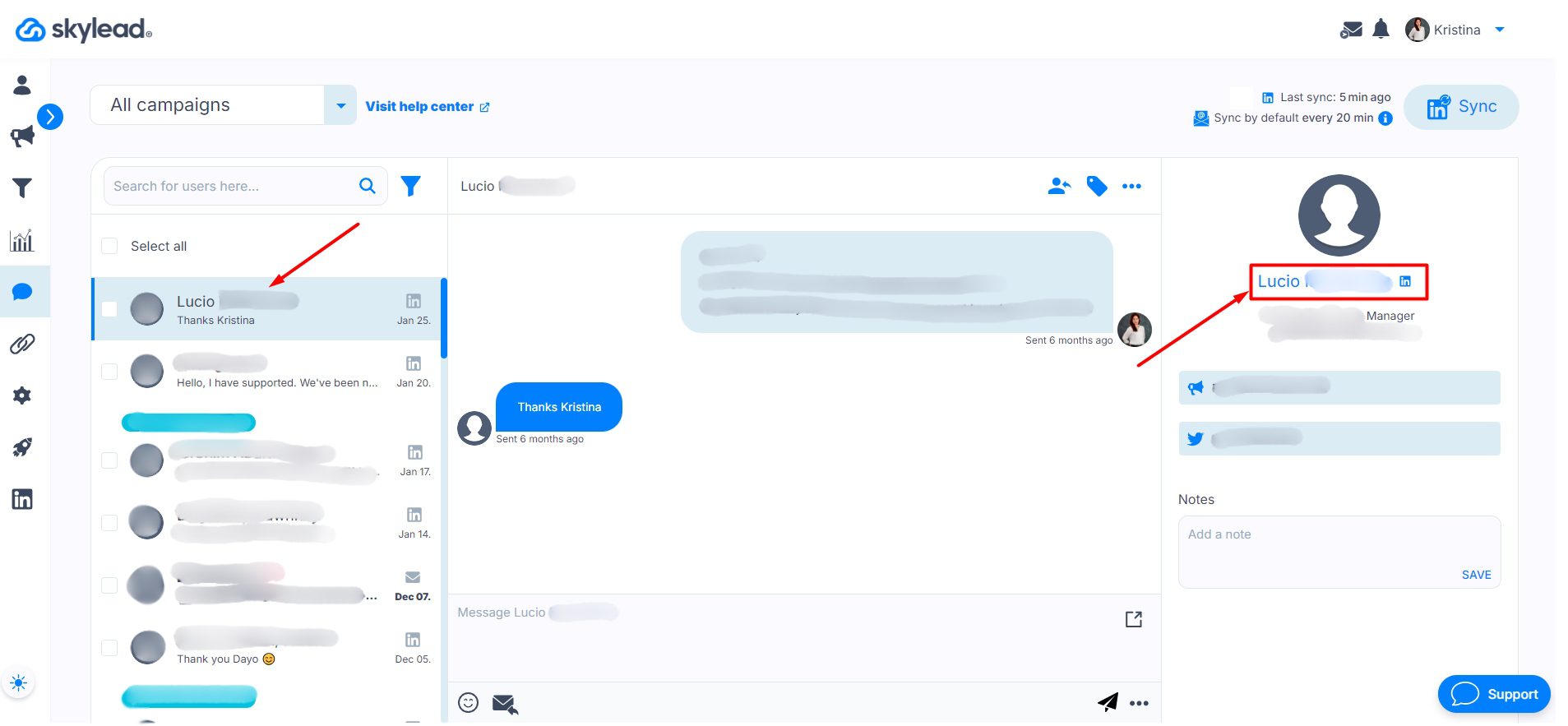
After that, you’ll be prompted to their LinkedIn profile, where, once again, you click the More button, and then Remove connection.
💡 Can I remove multiple LinkedIn connections at once or in bulk?
Unfortunately, LinkedIn doesn't offer a direct way to remove multiple connections in bulk; each connection must be removed individually.
While some third-party tools and browser extensions claim to automate this process, using them poses significant risks. These extensions often inject code into LinkedIn, making it easier for LinkedIn to detect and potentially restrict your account.
Therefore, it's important to be cautious when considering such options.
When should you remove your LinkedIn connections? [5+ reasons]
Here are some scenarios when removing connections from your LinkedIn network might be appropriate.
1. When your lead doesn't match your ICP or buyer persona
In sales, it's necessary to have a network that aligns with your Ideal Customer Profile (ICP) or Buyer Persona. If you have connections that don't fit these criteria, they can clutter your network. Removing these connections can help you maintain a more targeted outreach, effective LinkedIn presence and leave room for relevant connections. In other words, this ensures that your interactions are relevant for your sales goals.
To clarify, the ICP is a detailed description of the type of company who would benefit most from your product or service. The Buyer Persona, on the other hand, represents a key individual who works in your ICP. They are either decision-maker or active users of your product or service. This persona includes more than just demographics or job titles. A well-developed Buyer Persona includes detailed insights into the individual's motivations, pain points, challenges, and goals.
That said, here's why it is important to align your LinkedIn network with ICP and Buyer Persona.
Targeted outreach
Connections that do not match your ICP can lead to wasted efforts on outreach that is unlikely to convert.
Relevant content sharing
Sharing content customized to your ICP and buyer personas is a key strategy in nurturing leads. When your network consists of irrelevant connections, the engagement metrics for your posts can suffer.
Data-driven decision making
A network cluttered with irrelevant connections can skew your data analytics, leading to inaccurate insights. Maintaining a network that mirrors your ICP ensures that the data you collect from interactions and engagements is more accurate.
Enhanced engagement
A focused network encourages meaningful interactions. When your connections align with your ICP, the likelihood of engaging in mutually beneficial conversations increases. This leads to stronger relationships and more opportunities for conversions.
Optimized sales funnels
Connections outside your ICP can disrupt your sales funnel. You may attract leads that are less likely to progress through your business’s funnel stages.
If you remove connections on LinkedIn, you can streamline your sales process. This ensures that each stage of the funnel is populated with high-quality leads that are more likely to convert.
2. Remove a connection that you might suspect to be a fake account
If you stumble upon a LinkedIn connection that seems fishy, it's necessary to act swiftly. Suspected fake accounts can harm your network's integrity and reputation. Essentially, report these accounts to LinkedIn before removing them.
To report an account, you can go to the suspected fake profile in your LinkedIn network and:
- Click on the "More" button
- Select "Report/Block"
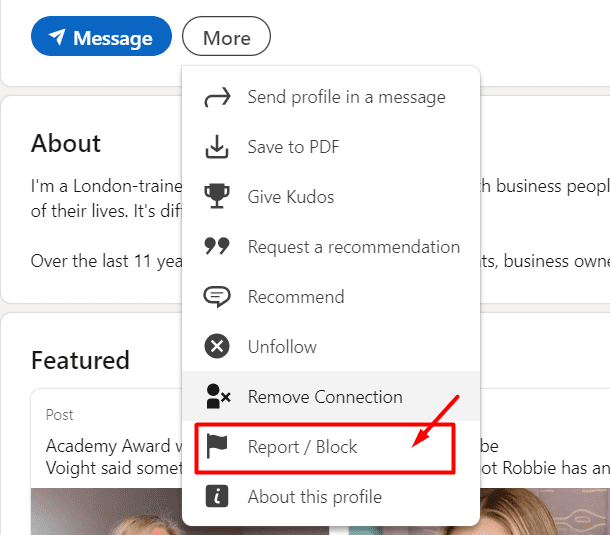
Then choose whether you wish to report or block them.
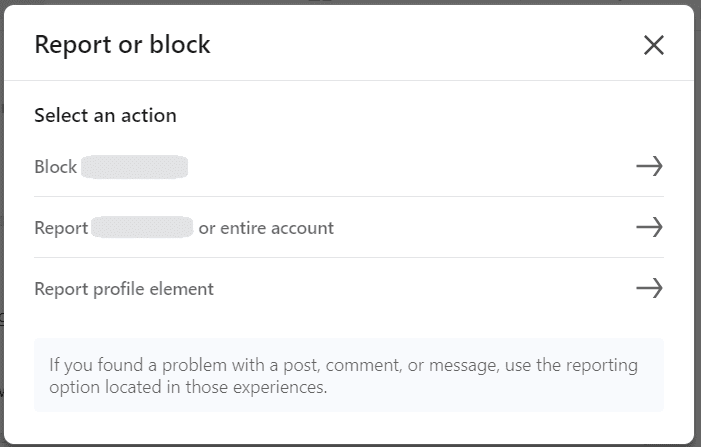
Lastly state the Reason for reporting, such as “This is not a real person," and submit your report.
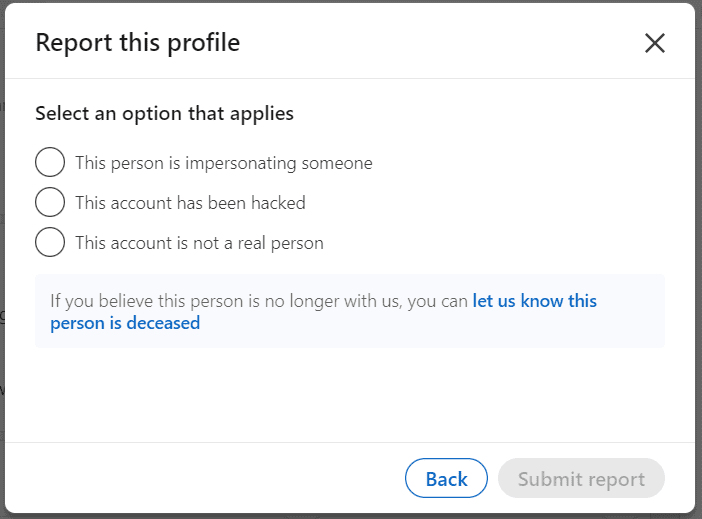
LinkedIn takes such reports seriously and investigates them promptly.
By reporting suspected fake accounts, you not only protect your network but also contribute to maintaining the platform's authenticity.
3. Shortlist profiles that practice excessive promotion
LinkedIn is a professional networking platform, not a billboard for constant self-promotion. If a connection floods your feed with too much promotional content, it's time to reconsider your connection.
Indeed, self-promotion is acceptable to some extent. However, if you don’t find value in it, excessive promotion can detach your audience. Also, it can reduce the value of your network.
In this case, it might be best to remove the connection who follows this practice regularly. Remember, quality connections matter more than quantity on LinkedIn, so choose your network carefully for maximum benefits.
4. Identify profiles that cause reputational damage
If a connection consistently posts inappropriate or offensive content, engages in unethical behavior, or tarnishes your professional reputation by association. It's best to remove them from your network to protect your own brand.
Moreover, negative ties can hold back your career and block opportunities, whether due to unprofessional actions or unsuitable posts. Staying connected with such people can reflect poorly on you.
Deleting these connections protects your reputation and ensures you're linked only with those who share your professionalism.
By refining your network, you show you're serious about maintaining an excellent online image and securing your reputation.
5. Going through a career shift? Reorganize your LinkedIn connections
When you undergo a career shift, it's essential to reassess your LinkedIn connections. As you transition to a new professional field, many of your current connections may not align with your new aspirations.
Therefore, it's necessary to surround yourself with individuals who can support and facilitate your success in your new role. By removing connections, you create space for new connections that can help you thrive in your chosen field.
Moreover, keeping your network to your evolving career path ensures that you're connected with the right people.
6. Check for professional misalignment in your LinkedIn connections
Your LinkedIn network should consist of professionals who align with your career goals and values. Suppose you find that a connection's professional interests or behaviors are not in line with yours. Consider it may be beneficial to remove them from your network.
Moreover, you should not maintain connections with individuals irrelevant to your professional journey, as it can dilute your network's effectiveness. Whether it's differing ethical standards, conflicting business practices, or simply a lack of collaboration.
What happens when you remove a connection from your LinkedIn network?
When you remove a connection from your LinkedIn network, several consequential actions ensue.
- First off, any endorsements or recommendations you received from that connection will disappear. If you reconnect later, those endorsements or recommendations won't come back automatically,
- Moreover, once you've hit the Remove connection button, that person's profile will no longer be accessible to you. This means no more peeking at their updates or checking out their latest achievements. It's a clean break, ensuring that your LinkedIn feed stays focused on what matters most to you.
Does LinkedIn notify the other person when you remove a connection?
LinkedIn does not notify the person when you remove them from your network. This means you can clean up your connections without worrying about alerting the other party.
Whether you're simplifying your network for better engagement or distancing yourself from irrelevant contacts, the process is discrete and straightforward. LinkedIn respects your privacy by not broadcasting these actions to others.
How can you cancel the pending LinkedIn invitations to connect?
Canceling pending LinkedIn invitations is important for managing your network well. If you leave these requests hanging, they can clutter your network and make it less effective.
For detailed instructions on how to cancel LinkedIn invitations, check out our blog post How to cancel pending LinkedIn invites & boost your acceptance rate?
How to block connections from your LinkedIn account?
Blocking a connection on LinkedIn is a decisive step, ensuring a complete cut-off from the individual's profile and interactions.
Here's a straightforward procedure to block someone from your LinkedIn account.
Navigate to the person’s LinkedIn profile and hit the More button, and then Report/Block from the dropdown menu that appears.
Then, in the pop-up window, confirm your decision by clicking the Block [name of the person]. Lastly, finalize the process and LinkedIn will block the individual from your account.
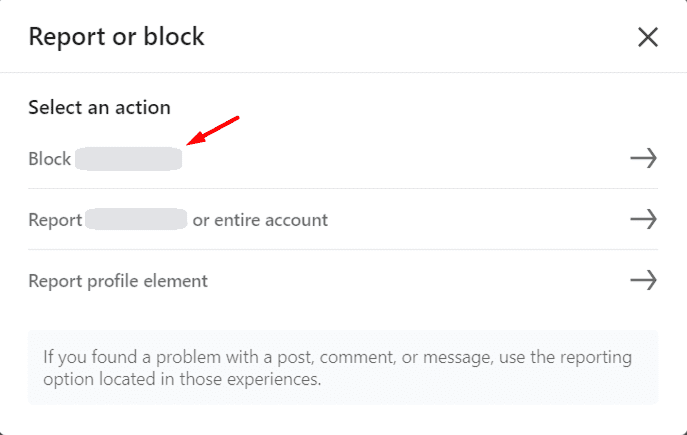
Moreover, they won't be notified about blocking, and they'll lose access to your profile, content, and messaging.
What’s the difference between blocking connections and removing connections on LinkedIn?
Let's identify the differences between blocking and removing connections. This can help you simplify your network and decide whether you need to block or just remove a connection altogether.
| Aspect | Blocking Connections | Removing Connections |
| Visibility of profiles | Both parties become invisible to each other on LinkedIn. | The removed person's profile disappears from your connections list. |
| Access to Shared Content | Any shared content between the two is inaccessible. | Shared content between the two remains accessible. |
| Messaging | Messaging each other through LinkedIn becomes impossible. | There is no impact on messaging unless you eventually actively reach out. |
| Notification | The blocked person won't receive a notification. | The removed person won't be notified but may notice the change if they explore your profile manually. |
| Profile Features | Their profile stops appearing in features like "People Also Viewed." | Their profile vanishes from specific LinkedIn suggestions. |
| Endorsements/Recommendations | Any endorsements or recommendations from that person disappear. | Endorsements and recommendations disappear. |
Can you have too many LinkedIn connections?
When it comes to your LinkedIn profile, quality is more important than quantity. More is not always better.
Moreover, when you reach 500+ connections on LinkedIn, your visibility increases a lot. With over 5,000 connections, you can significantly boost your growth.
Even though you can't keep adding connections forever, LinkedIn limits you to 30,000 1st-degree connections.
Your ideal LinkedIn connections might be a mix of,
- Clients/Customers
- Networking Partners
- Vendors
- Coworkers
- Family
This proportion helps to keep your network valuable and manageable.
However, too many connections can clutter your feed and make it difficult to see important updates. You might miss out on valuable information or opportunities because your network is too large and irrelevant.
Definitely, to decide if you need to trim your network, think about who adds value. Keep those who regularly share valuable insights or opportunities. If someone doesn't add value or no longer aligns with your goals, consider removing them.
How do you hide LinkedIn network connections?
Want to keep your LinkedIn connections private? Follow these simple steps to hide your LinkedIn network connections and maintain privacy.
Firstly, open LinkedIn, navigate to your profile and hit the Me icon at the top of your LinkedIn homepage. Then, select Settings & Privacy from the dropdown menu.
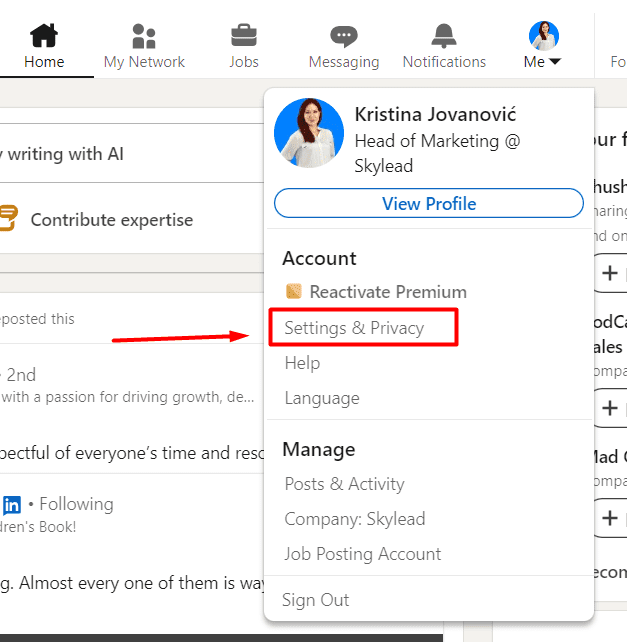
Then, within the settings menu, navigate to the Visibility section and under Visibility of your profile & network choose Connections.
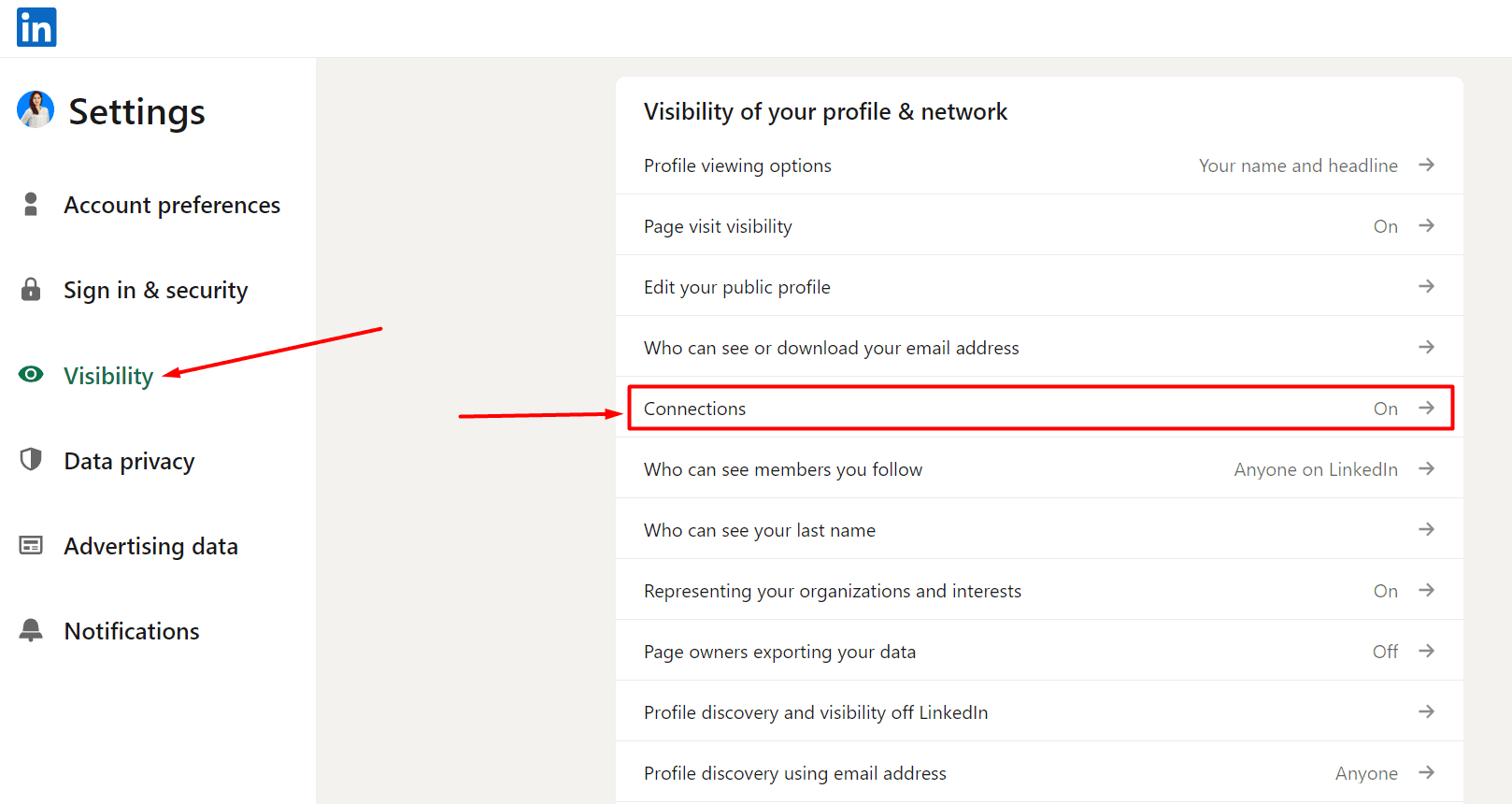
From there, you can either turn on or off the visibility of your connections if you want other people in your connections to view your network, and save changes.
By doing this, your LinkedIn network remains confidential, protecting your professional relationships from prying eyes.
Frequently Asked Questions (FAQs)
What is the difference between “unfollow” and “remove” connections on LinkedIn?
Choosing to 'unfollow' someone on LinkedIn hides their updates from your feed but maintains your connection and communication options. Conversely, 'removing' a connection completely cuts off updates and communication, and removes the individual from your connections list.
When and how do you unfollow people on LinkedIn?
Knowing when to unfollow someone is necessary to maintain field-relevant connections on LinkedIn. If their content is irrelevant to your business or industry, it might be time to unfollow them. Moreover, if they post too frequently and clog your feed, consider unfollowing to keep your feed manageable.
Similarly, if someone is consistently posting content that goes against your values, unfollowing them can help maintain a positive environment.
Here are simple steps you can follow to unfollow people on LinkedIn,
- “Go to the profile” of the person you want to unfollow.
- Click on the "More" button located on their profile.
- Select "Unfollow" from the dropdown menu.
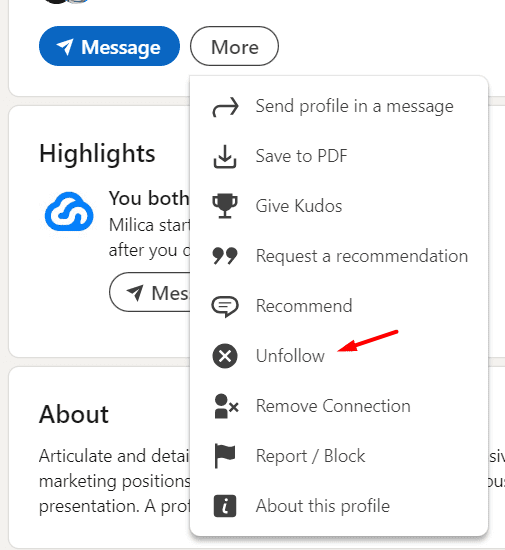
Can I bulk unfollow people on LinkedIn?
Unfortunately, LinkedIn does not currently offer a feature to bulk unfollow or remove connections in one go. This means that if you wish to remove a large number of connections, you'll need to do so individually.
What are the types of restrictions for sending connections?
On LinkedIn, various restrictions ensure a smooth networking experience.
Connection Limits: You can send approximately 20-25 connection requests per day, totaling around 100 per week. If you have more than 700 unanswered invitations, LinkedIn may request that you cancel some of them.
However, there are strategies to bypass the LinkedIn connection limit. For more information, you can visit our blog post: Ways to bypass LinkedIn connection limit.
Profile Quality: Your ability to send connection requests may be restricted if your profile is incomplete or appears suspicious. LinkedIn may require you to enhance your profile's credibility before allowing you to send more requests.
Behavioral Restrictions: If you've been reported for spamming or sending too many connection requests without personalized messages. Then, LinkedIn may temporarily restrict your ability to connect with others.
Pending Invitations Limit: LinkedIn limits the number of pending invitations you can have to prevent spamming and overwhelming others with connection requests.
Overall Activity: LinkedIn may limit your connection capabilities if you've recently joined the platform or need to be more active. They may want to see more engagement from you before allowing more connection requests.
Prepared to compress your LinkedIn connections?
Cleaning up your LinkedIn connections is necessary for keeping your network relevant and healthy.
Moreover, by removing inactive or irrelevant connections, you make sure that you're connected with the right people. You can keep people who align with your professional goals to boost your credibility and open doors to meaningful opportunities.
Skylead makes this process effortless with its all-in-one tool. You can identify and remove unwanted connections based on your outreach history, saving you time and energy.
Disclaimer: Skylead is not affiliated, endorsed by, or connected with LinkedIn in any way.
If you ask yourself how to connect with someone on LinkedIn, you are in the right place. We will go over a couple of methods you can use to add someone to LinkedIn, including the LinkedIn App, so you can grow your network and prepare for LinkedIn lead generation.
However, that is not all. Keep in mind that building your network is all about building relationships. Thus, we will mention what you need to do before adding connections. Moreover, we will get into the core of what is truly important for a successful professional relationship and, therefore, a successful business.
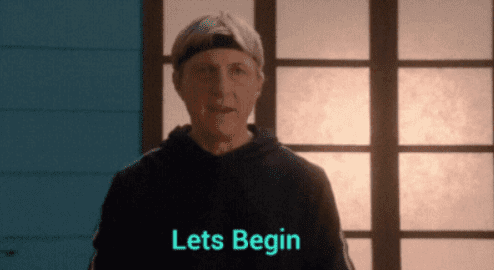
How to connect with someone on LinkedIn?
Building your network is not just about having a large connection number. It is about establishing relationships, getting in touch with the people from your industry, sharing experiences, and growing your business.
Furthermore, 80% of professionals found networking crucial for career success*. For example, salespeople and hiring managers proved this by finding their perfect leads and ideal candidates while growing their network. And with the rise of social selling and word-of-mouth recommendations, networking on LinkedIn really did become essential for professionals in today's world.
So to take full advantage of networking, let’s start from the beginning - how to connect with someone on LinkedIn.
8 ways to connect with someone on LinkedIn
To connect with someone on LinkedIn via your PC, you can use one of these ways:
- Add connections when creating your LinkedIn account
- Send a connection request via their profile
- Connect on LinkedIn via the “People Also Viewed” section
- Send invites to people from Search Results
- From the “People You May Know” section
- Use the “More Suggestions For You” Section
- Connecting with people from events page
- Asking other network members
Add connections when creating your LinkedIn account
First, when you create your LinkedIn account, you can add connections you might know in real life. LinkedIn recommends them from the school you chose as your education or from the company you set to work in.
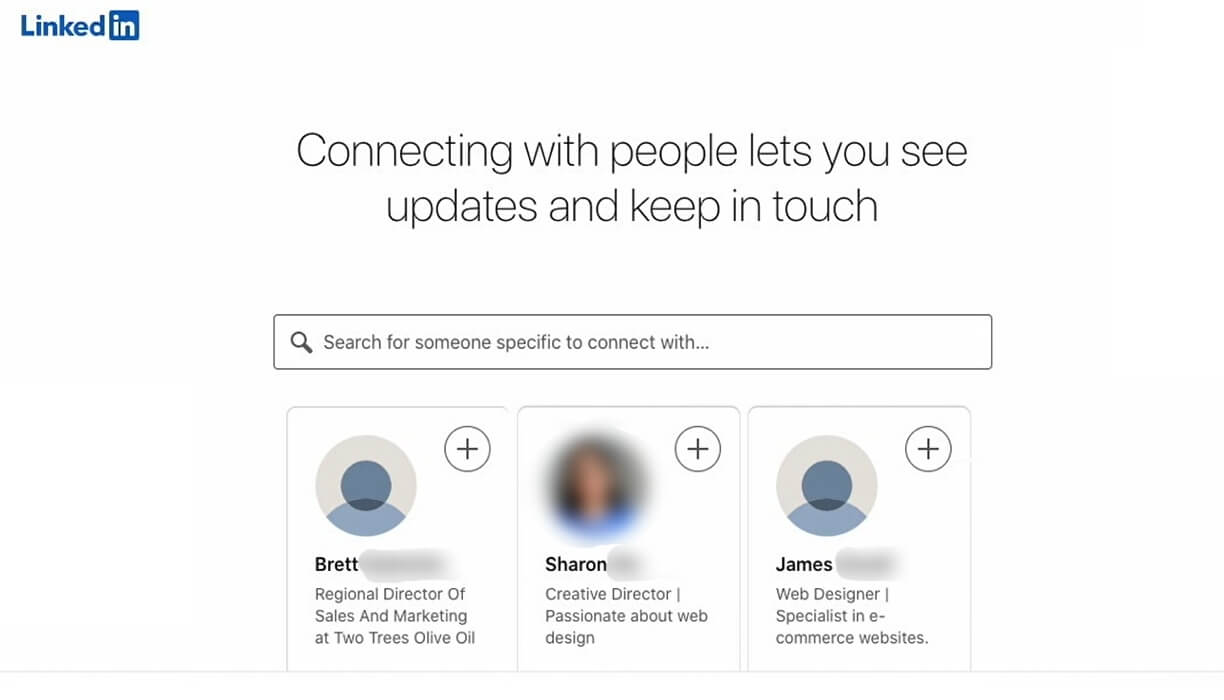
In addition, you should know that if you add people to your network using this option, you will not be able to write a personalized note. In other words, when you click the + button, the people you sent the invite to, will only get the following LinkedIn’s general message:
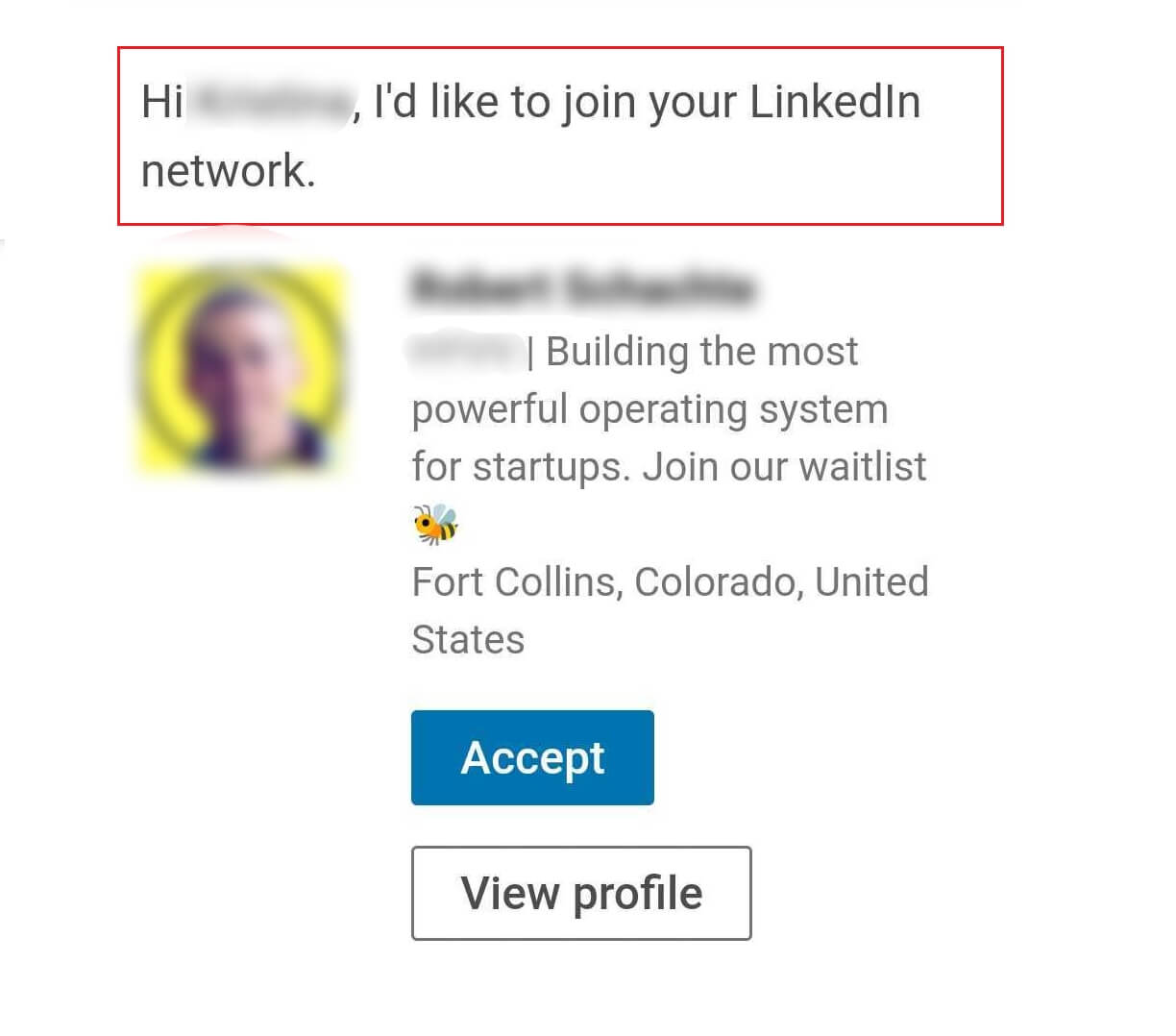
Send a connection request via their profile
The easiest way to connect with someone after browsing through their profile on the desktop is to get back to the top of their LinkedIn profile and hit the Connect button.
If you plan to connect with someone on a LinkedIn app, the process is similar to desktop. The slight difference is that you need to go to the More Options button and click Personalize Invite. Otherwise, if you click the Connect button only, your invite will be sent automatically, and you won’t be able to personalize it.
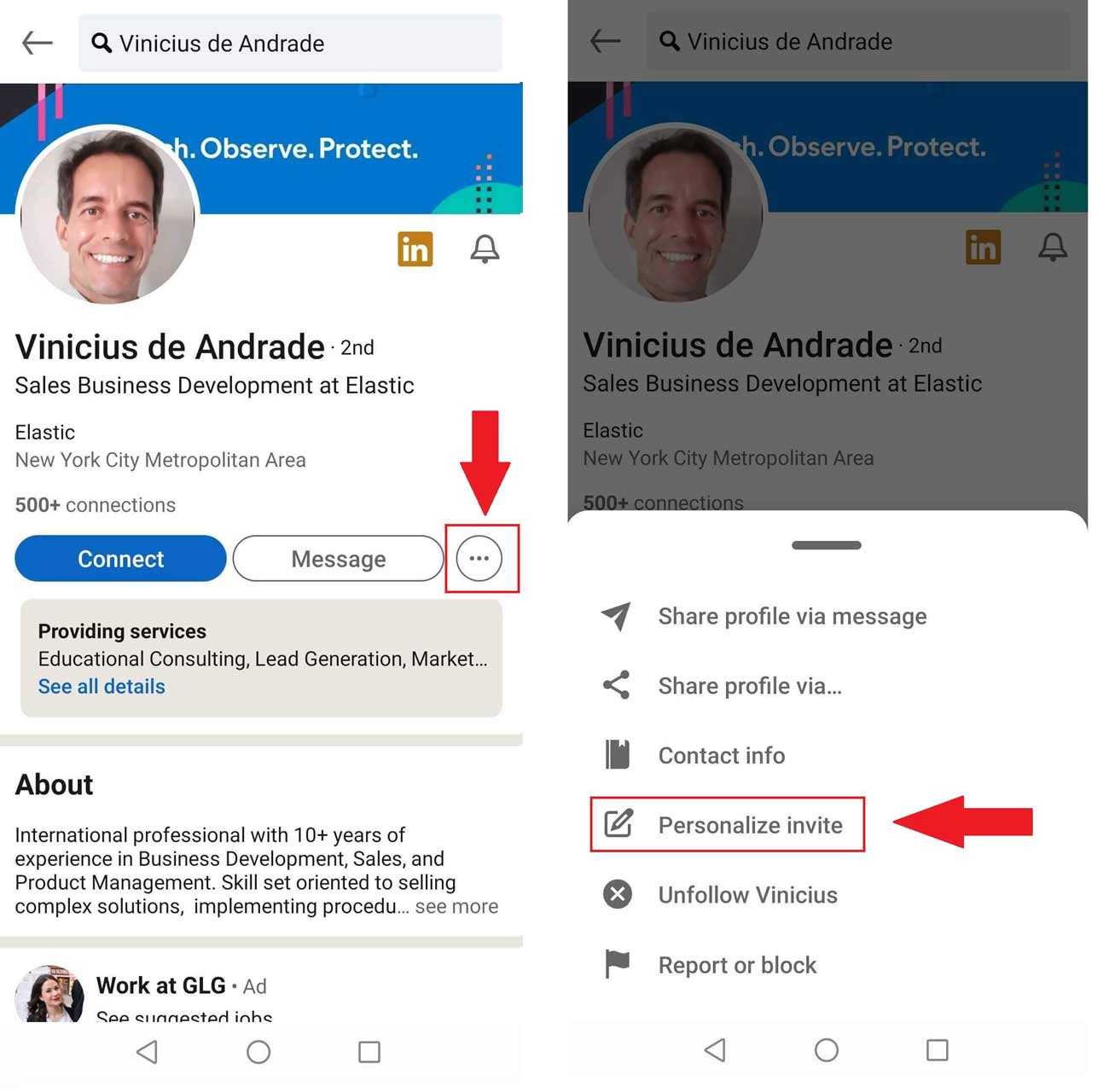
Sometimes you will notice that a LinkedIn user doesn’t have an immediate Connect button on their profile. This can happen because of two reasons:
- The user either has their creator mode on;
- Or they set the Follow button as primary via their Settings & Privacy page.
So you would need to click the More button and then Connect option from the drop-down menu. In addition, this is how to connect on LinkedIn with your favorite creators.
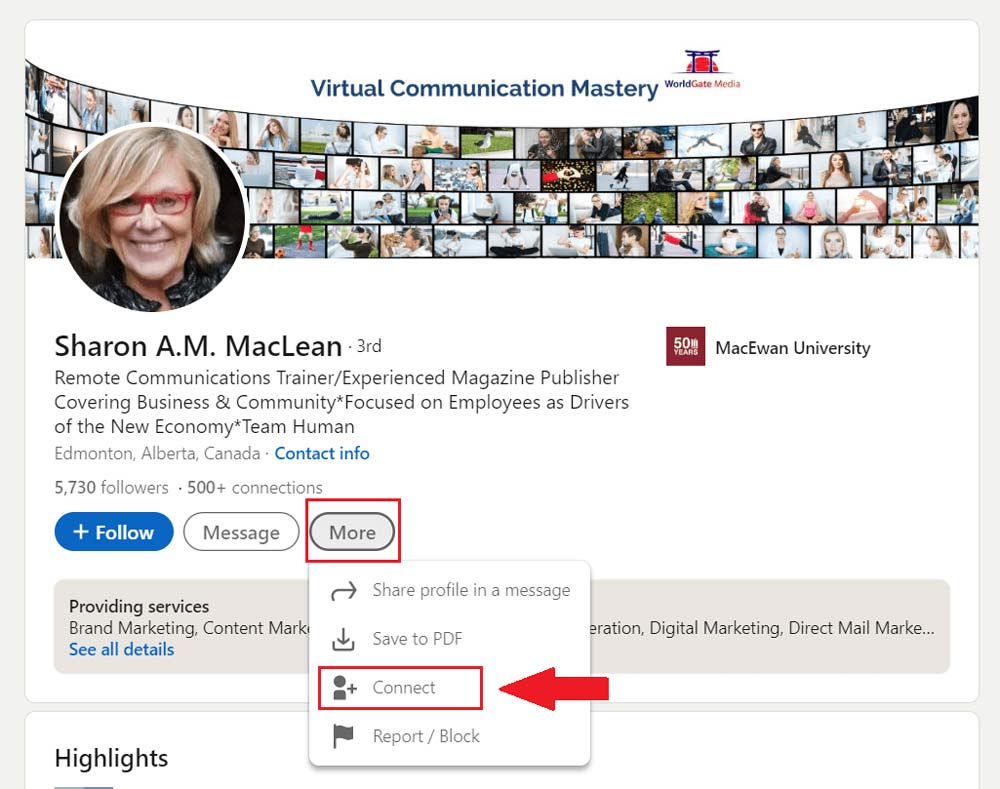
Here is what it looks like in the LinkedIn app. Click on the ··· button and choose if you wish to send a blank or a personalized invite.
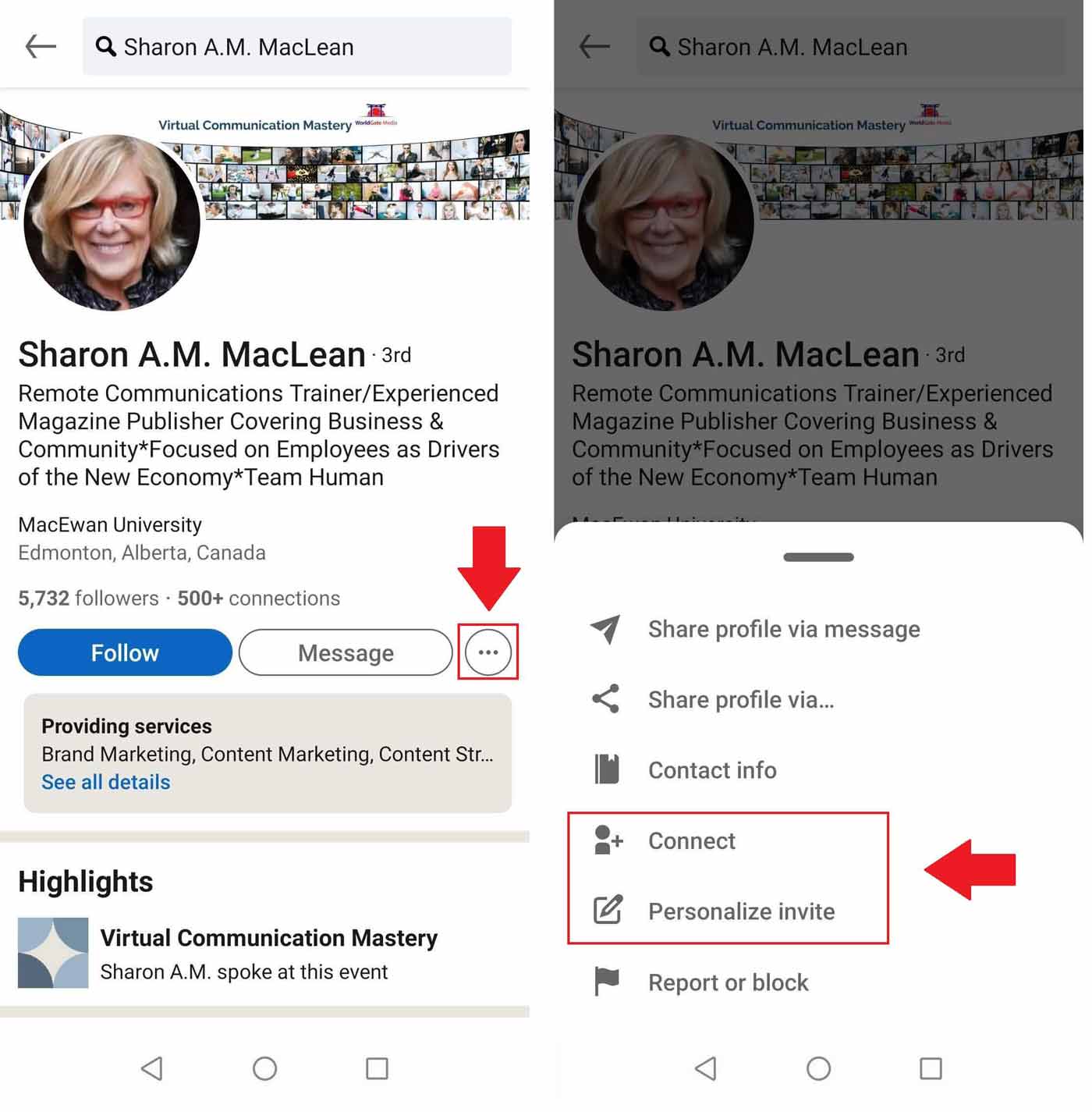
Next, if this person is your 2nd-degree connection, you will have the option to type in the personalized message and let it be on its merry way.
To clarify, you need to write a personalized message to increase the chances of the user accepting your invite. However, there are other reasons, as well.
Message personalization
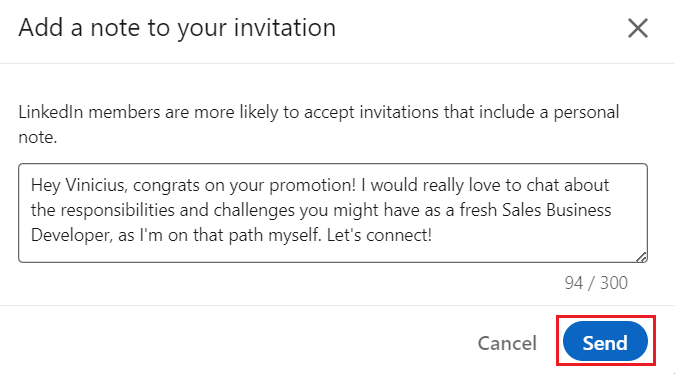
Firstly, we wish to build our network by building true relationships. Secondly, we want to decrease the chances of people ignoring, declining, and checking the “I don’t know this person” box. Too many refusals can result in a LinkedIn account restriction, as this will be one of many signals for LinkedIn that you might be a spammer.
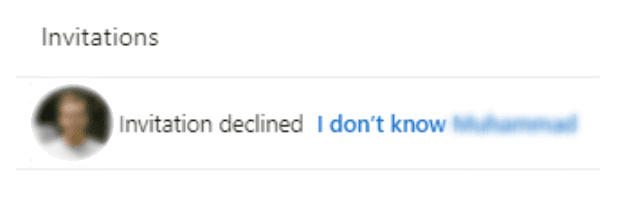
If, however, you wish to add a 3rd+ degree connection, you will first need to answer LinkedIn's question about how you know this person.
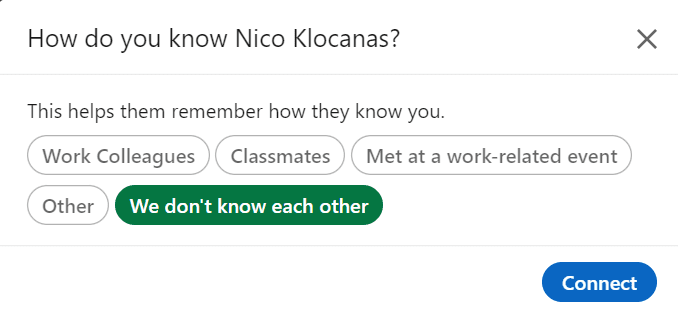
Should you say you don’t know them, you will see the following alert.
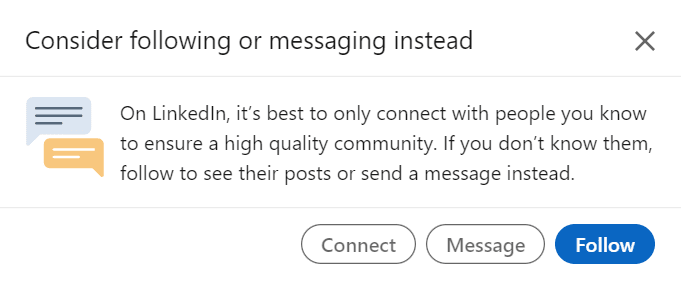
If you have a LinkedIn Premium subscription, you will be able to send a message but you will use up one LinkedIn InMail credit.
Otherwise, you won’t be able to send messages. Instead, you can only write a note for your connection invite.
Connect on LinkedIn via “People Also Viewed” section
While we are still on the user’s profile, let’s show you another way how you can connect with someone on LinkedIn. If you look at the right end of the screen, you will notice the People also viewed section.
LinkedIn will recommend other people you can add to your network based on the user’s profile you are currently viewing. So, all you need to do is to either connect straight from there or visit that person’s profile to decide if you wish to connect with them on LinkedIn or not.
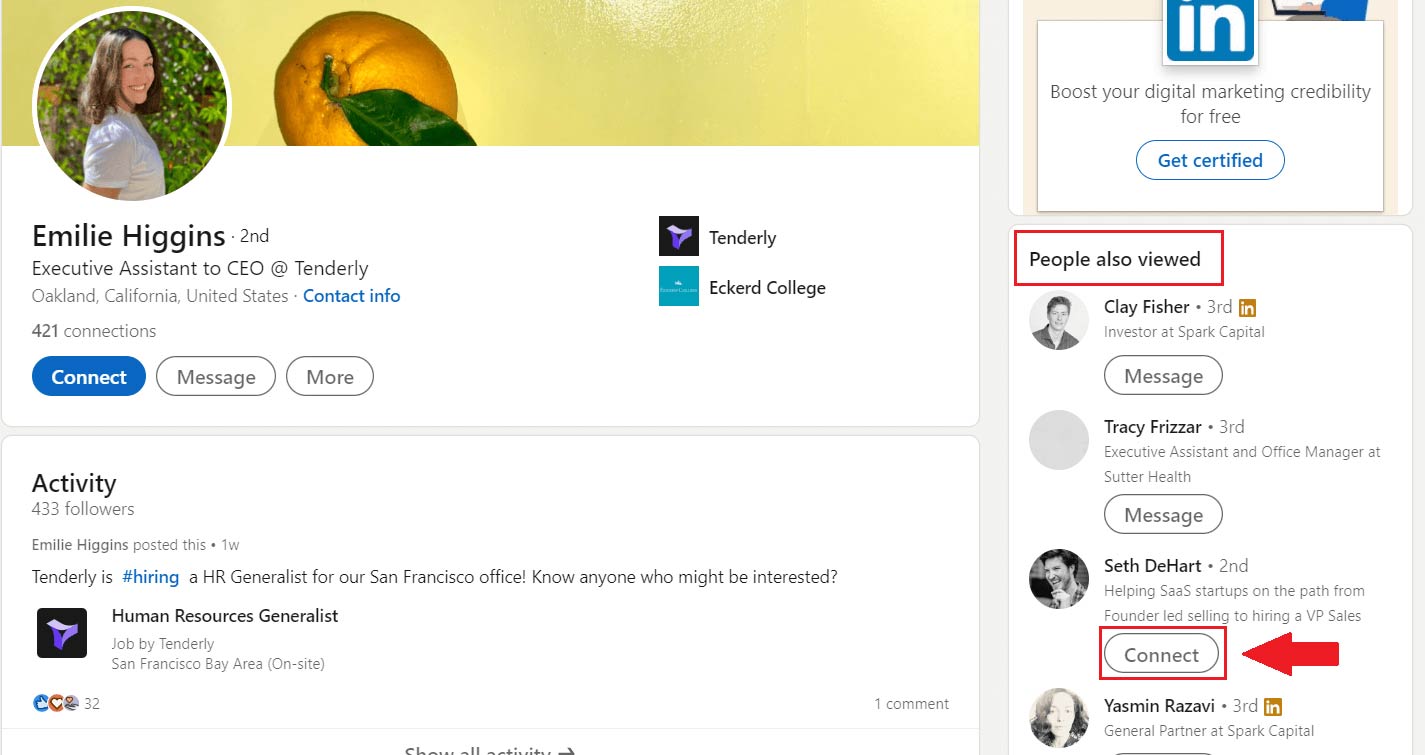
Send invites to people from search results
If you wonder how to connect with someone on LinkedIn without going through their profile, you can do so using a couple of ways. The first one is to do the "LinkedIn prospecting" of your own and add a connection from the Search Results Page. Simply click the Connect button right to their profile information.
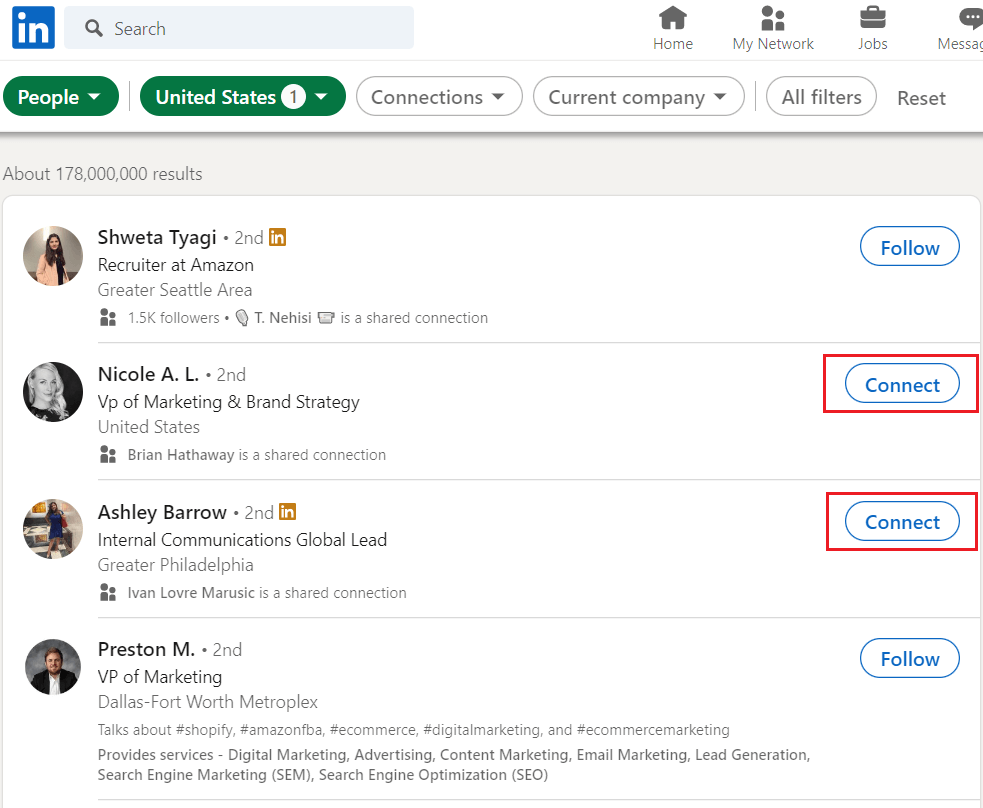
Here is how to connect with someone on LinkedIn via search results within the LinkedIn app. Only be aware that this way, you won’t be able to personalize your message.
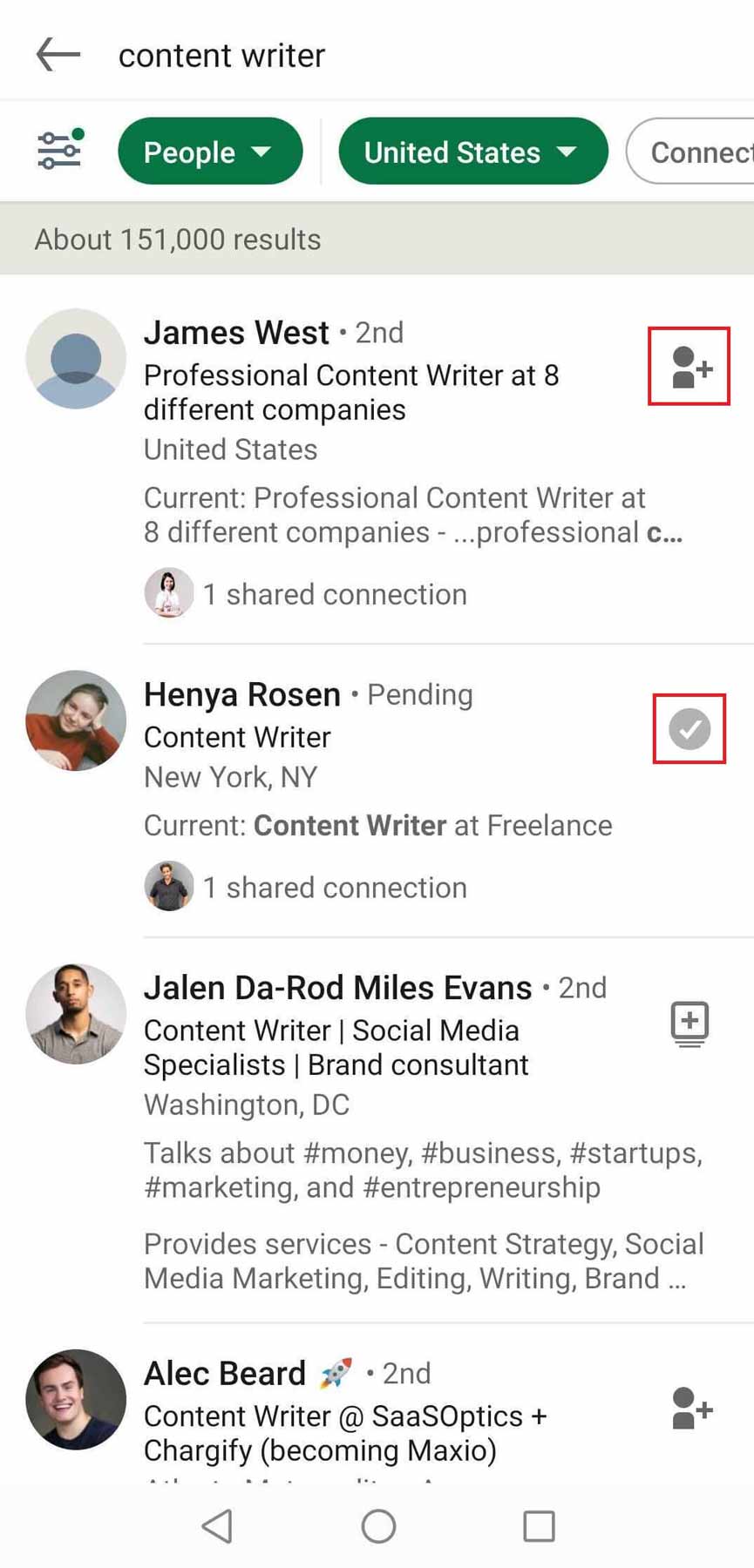
How to connect with someone on LinkedIn via network page
To send someone a connection request, you can also go to the My Network section at the top of the page.
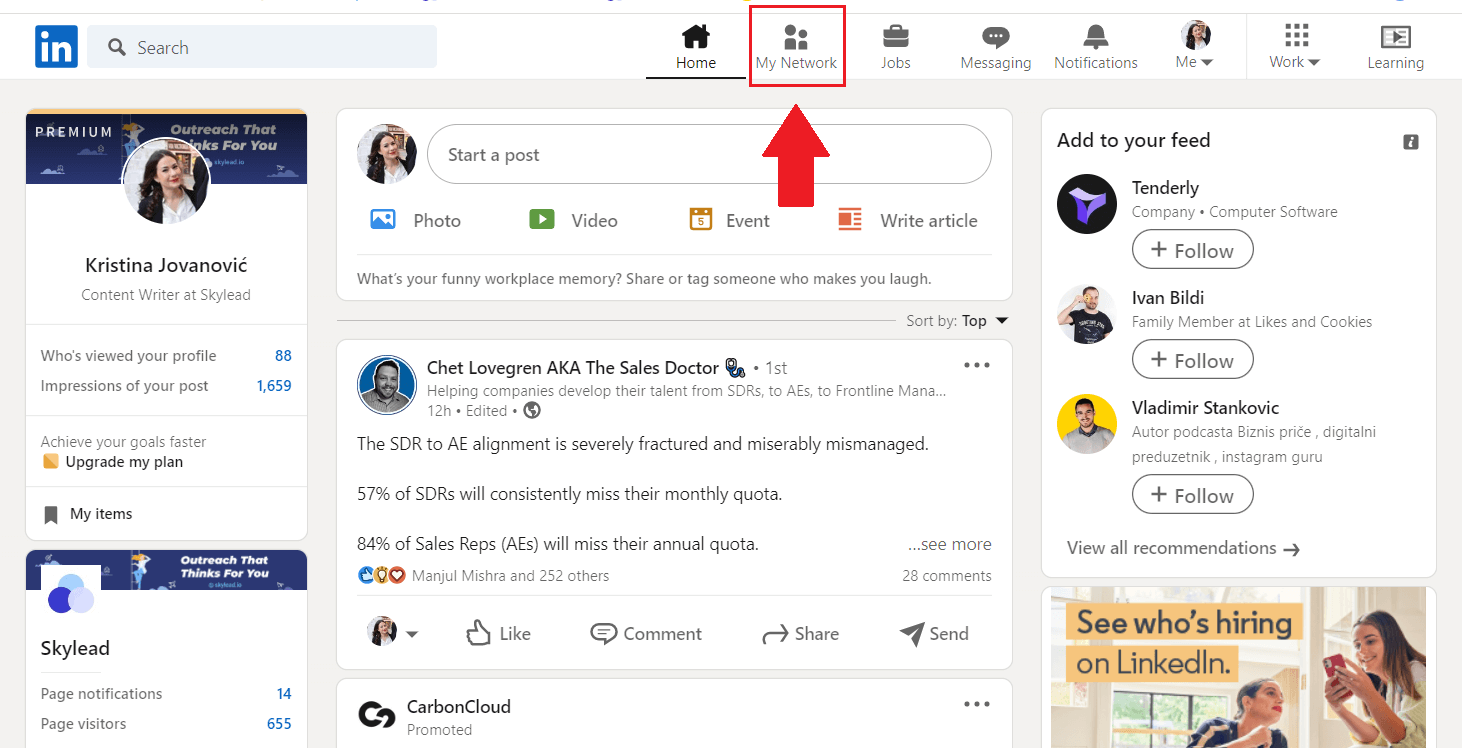
Once you do, you will see the list of pending invitations and options to manage your network. From here, If you scroll down a bit, you will have two ways on how to connect with someone on LinkedIn.
How to connect on LinkedIn from “People You May Know” section
After you pass Follow suggestions, LinkedIn will present users who have similar roles as yourself and offer you to add them. Simply find the People You May Know With Similar Roles section, browse through and add a few connections by clicking the Connect button below their name.
In addition, you should know that you won’t be able to personalize invites if you send them through this method. So, to personalize your invite messages, it’s best to go to that person’s profile and connect from there.
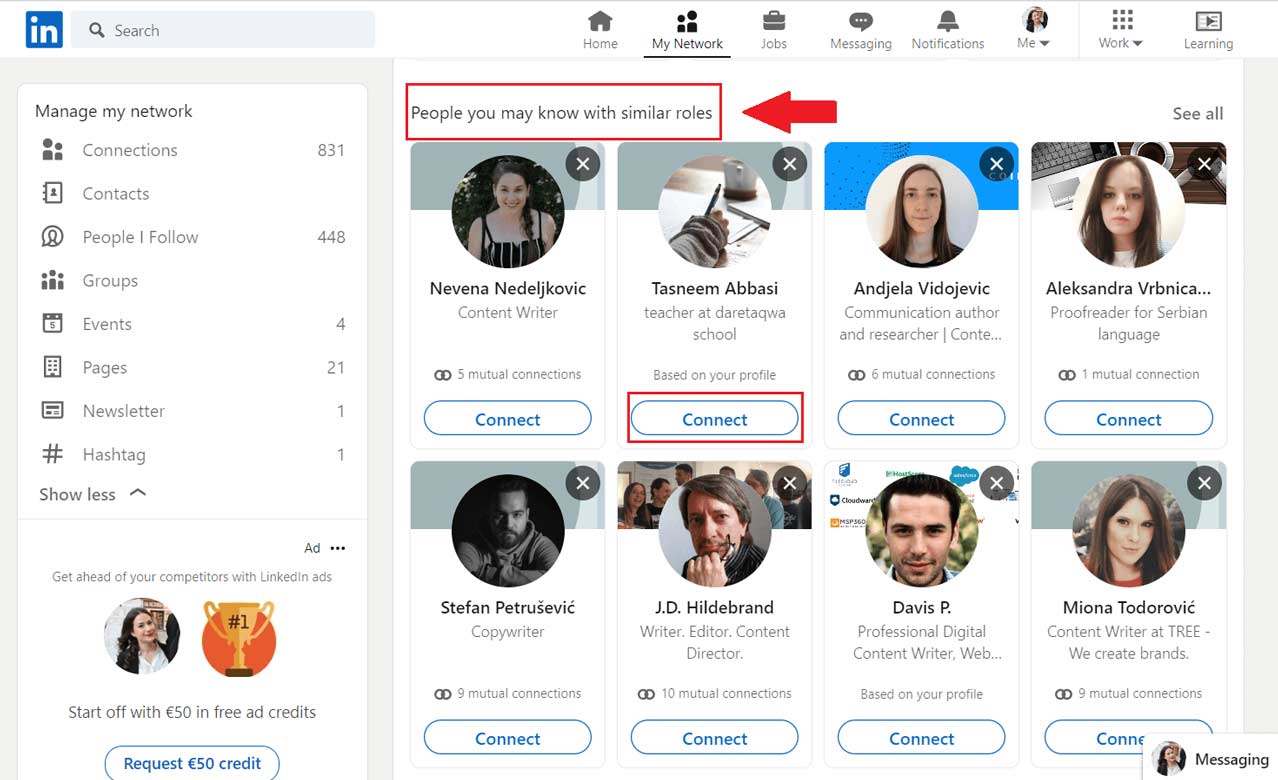
Use “More Suggestions For You” section to connect with someone on LinkedIn
If you scroll down a bit more, past the Groups you may be interested in, LinkedIn will surprise you with another suggestion section. In this case, LinkedIn will present the list of people you can add based on shared connections, mutual company, industry, or, again, job roles. Just be aware that this method does not support personalized invites as well.
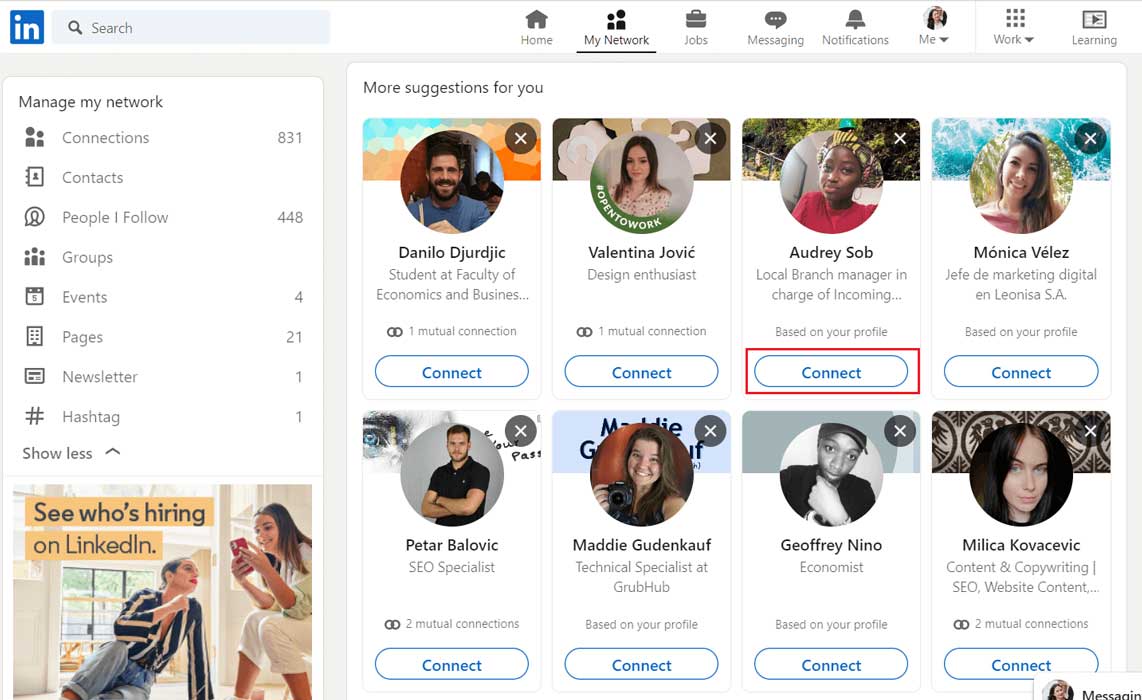
Add people who joined certain events
This is a nifty way on how to connect with someone on LinkedIn from the same event you attended and mingle. Simply go to the event’s page, and join by clicking the Attend button. Once you do, look at the right side of the screen and search for the Networking option.
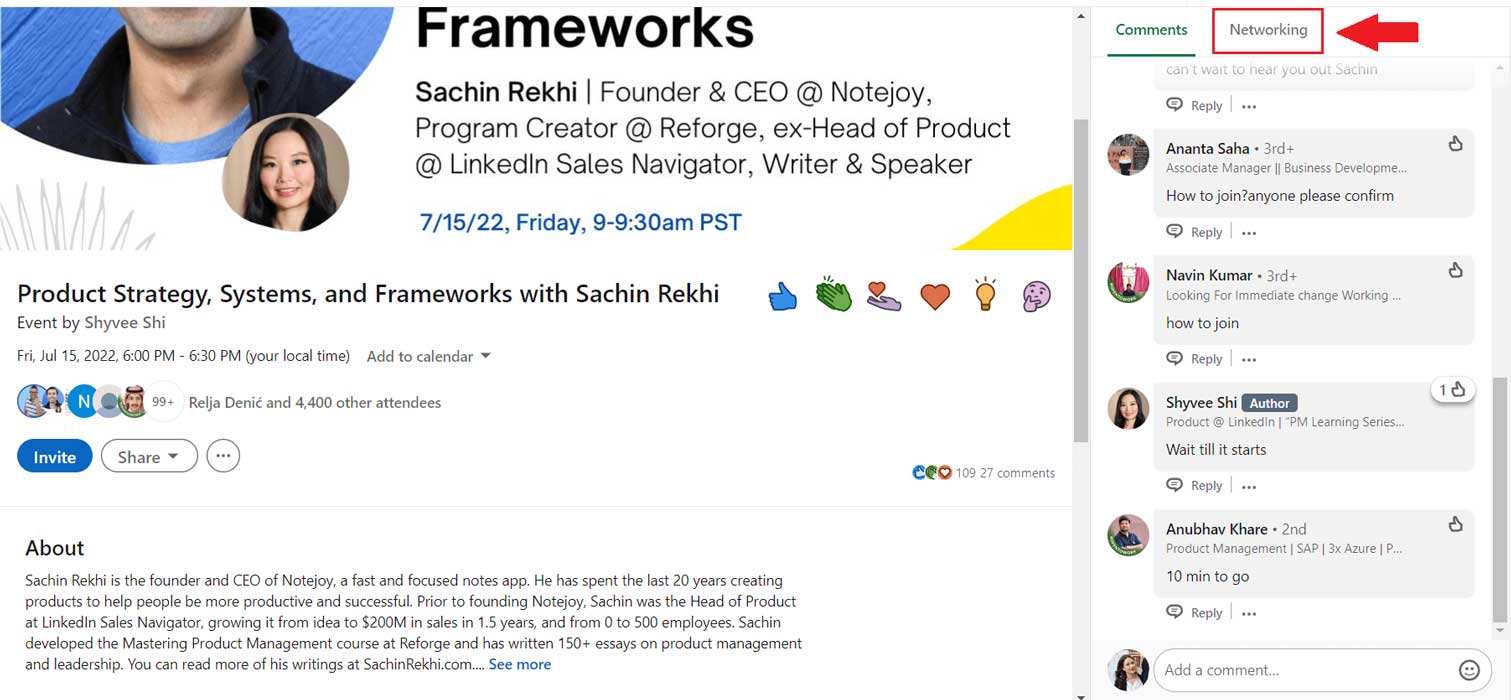
Lastly, browse the people who attended the event. When you find the one you wish to add to your network, click the ··· button and then Connect.
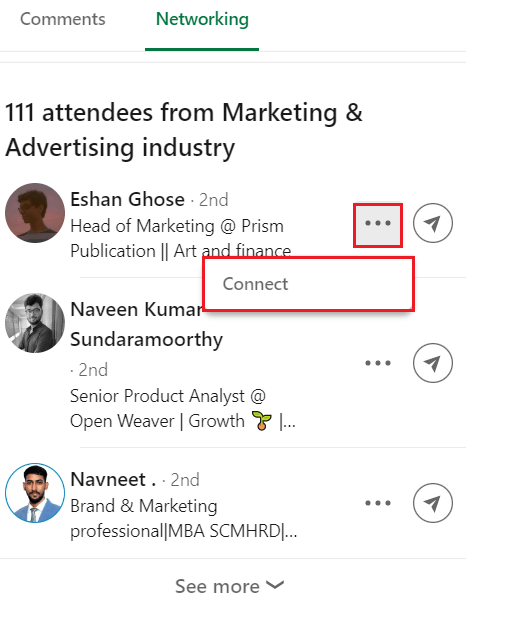
And here is how to connect with someone on LinkedIn using the LinkedIn app.
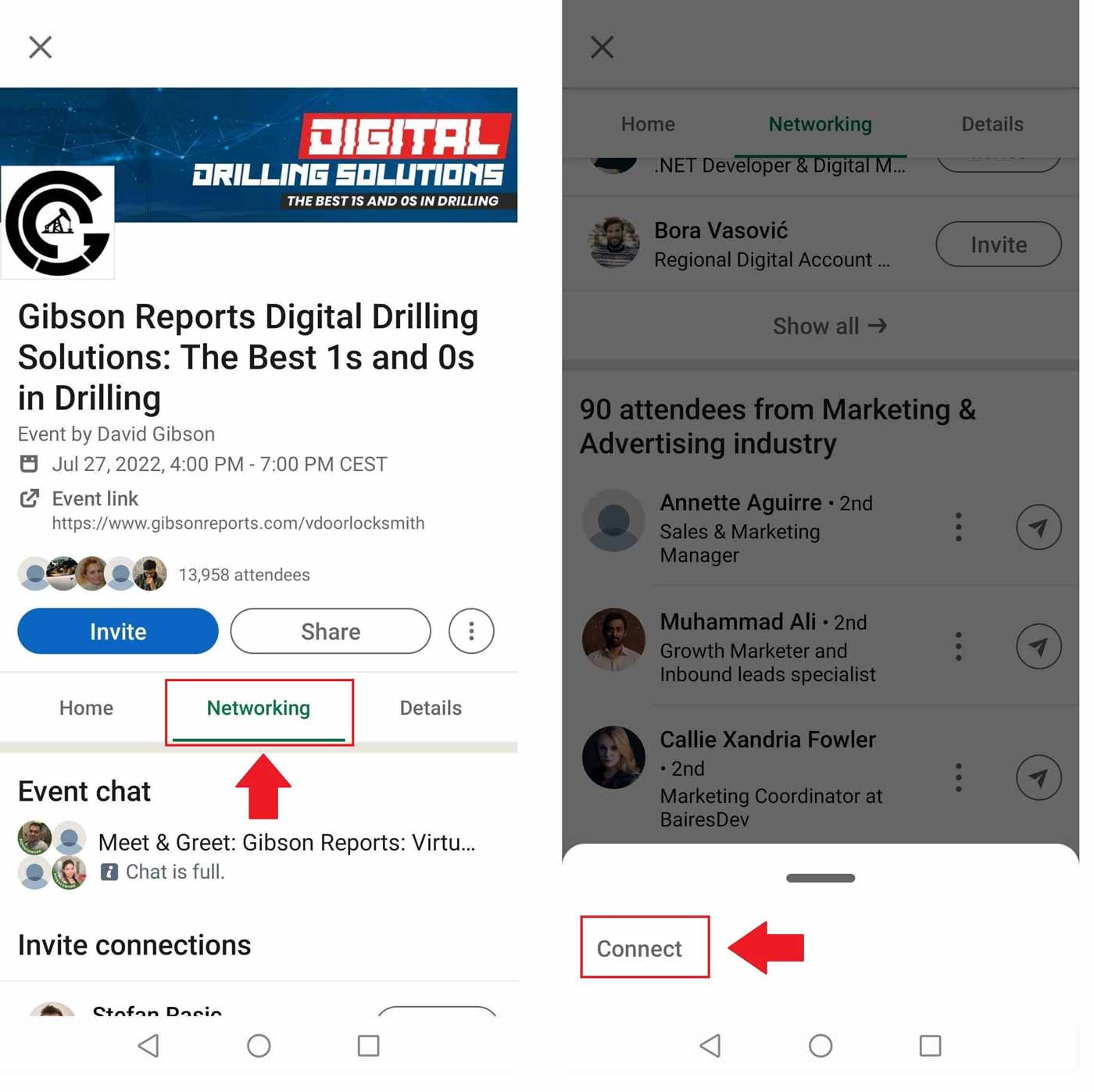
Asking other network members
Last, but not least, you can always ask other members of your network if they know anyone from your line of work or industry or if they can introduce you to someone. This is a nice way to get an introduction and connect with other people you otherwise cannot reach.
Moreover, if you are a recruiter or salesperson, this is a nifty way to get to your lead or find an ideal candidate you’d probably miss.
4 things to do before connecting with someone on LinkedIn
1. Set up your LinkedIn profile
Imagine a scenario where you get a connection request from a user with no profile, LinkedIn headline, or displayed experience to learn more about them and what they do. You wouldn’t accept that request, would you? Thus one of the first things you should do is pump up your LinkedIn profile and allow people you don’t know in real life to get to know you.
2. Craft your message carefully
Remember when we said you need to personalize your message to increase the acceptance rate and build your network more efficiently? Well, by structuring your message carefully, you can.
If you are sending the message to a person you don’t know in real life, firstly look them up and personalize your message accordingly. For example, you can research the content they created, what their occupation is, or what company they work in.
Apart from personalization, here are other things you should consider when creating your invite message:
- Clearly state why you want to connect with them;
- Write a compelling copy to catch their attention;
- Include a hook or call-to-action so you can continue the conversation once you are connected;
- Introduce yourself;
- Be polite and professional.
So, for example, you can try emphasizing your mutual connection:
Hi {{firstName}},
I noticed that {{Mutual Connection Name}} is in your network. We worked together at {{Company}}. Nevertheless, as we both work as {{Occupation}} I would love to have you in my network.
Or you can target their expertise and reach them out like this:
Hello {{firstName}},
Love the work you are doing. I followed your advice regarding {{Topic}} that you shared here, on LinkedIn, and it brought me {{Achieved Results}}. I would love to connect!
We have complete blog posts on connection request message templates and using personalization to scale up your business, so be sure to check them out.
3. Prepare to engage
After connecting with someone, it is essential to maintain and build a relationship. Thus, keep engaging with the people on LinkedIn via post engagements, an endorsement, or an occasional message. This can nourish your relationship and can lead to future opportunities.
4. Connect with someone you know first
As we mentioned previously, once you create your profile, LinkedIn will suggest contacts you might know so you can add them first. Thus, it’s better to strengthen your network with your known contacts rather than trying to add unknown people from the beginning. Try finding your coworkers, classmates, or simply your friends.
Is there a solution to send the connection invites for me?
If you plan to use LinkedIn for sales or recruiting and don’t have time to do the outreach, build your network, and personalize messages on a large scale, then meet Skylead, a sales engagement & Cold Email Software that does the outreach for you.
Let’s dive into the tool itself. We previously explained how to contact people who attended certain events. Thus, here is how Skylead can do it instead of you.
Go to the desired event, and attend it. Once you do, click the Attendees option.
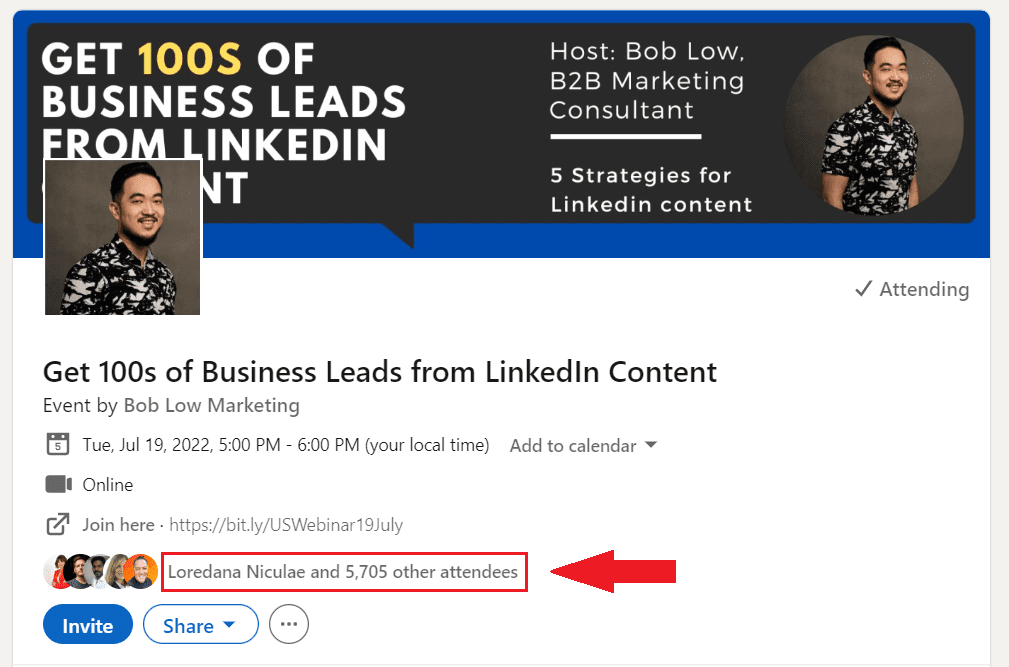
Then copy the attendees search result URL.
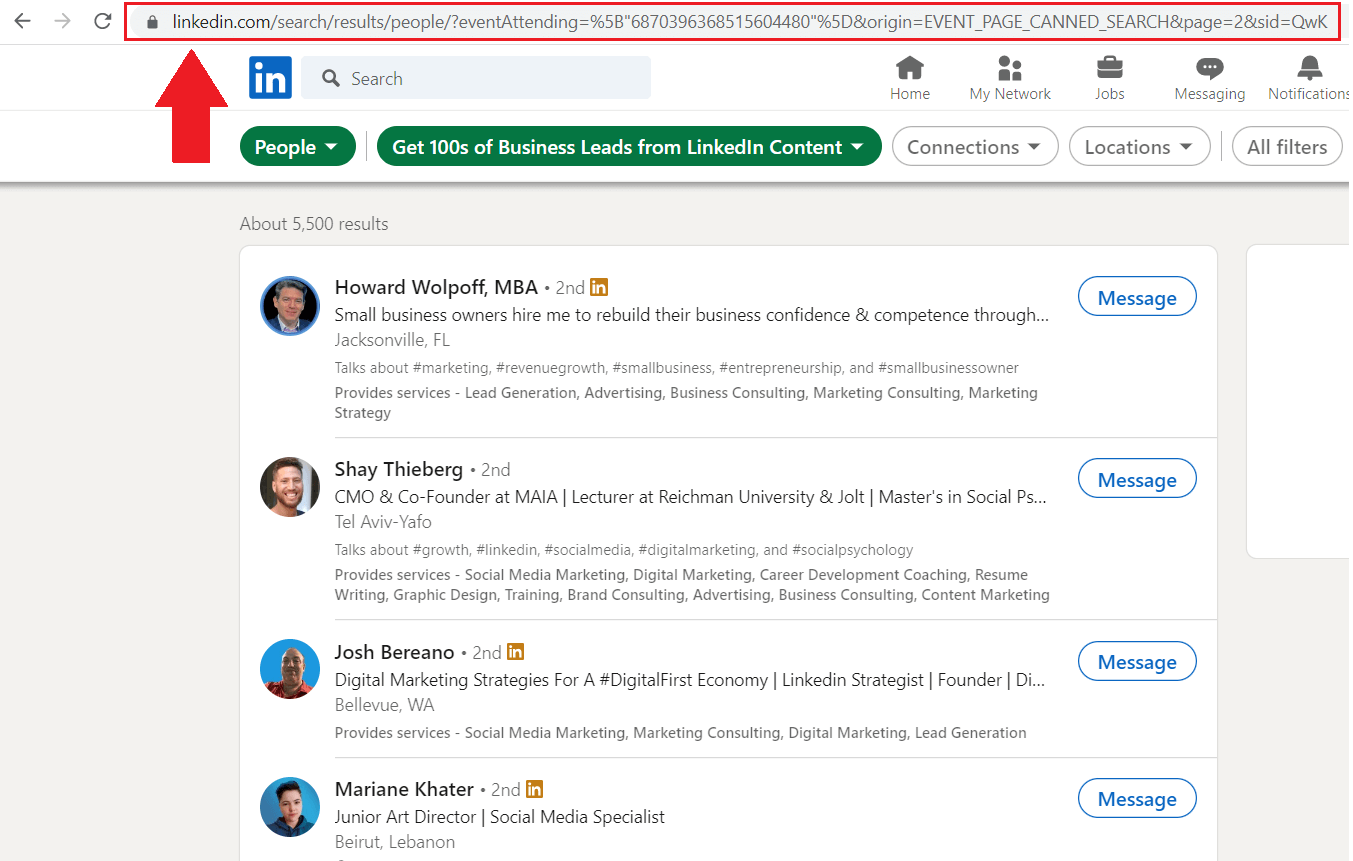
Next, go to your Skylead Campaign creator, choose the campaign source, give your campaign a name and paste the URL in the LinkedIn URL field. Don’t forget to select the Connection type.
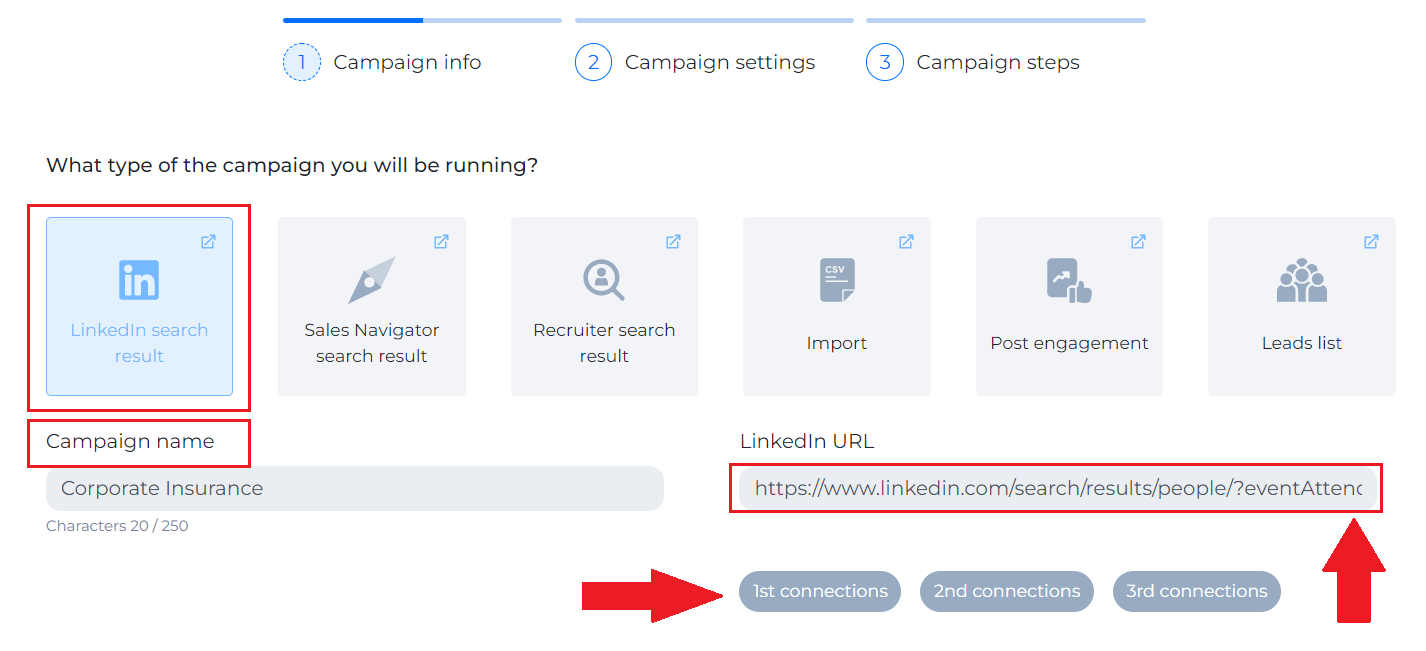
Now we are at the Smart Sequence page. From here, you can drag and drop desired actions you wish Skylead to perform.
We will start with the steps such as Follow, Find & Verify Business Email and invite them to connect. Next, we will personalize the invite message via Skylead's variables.
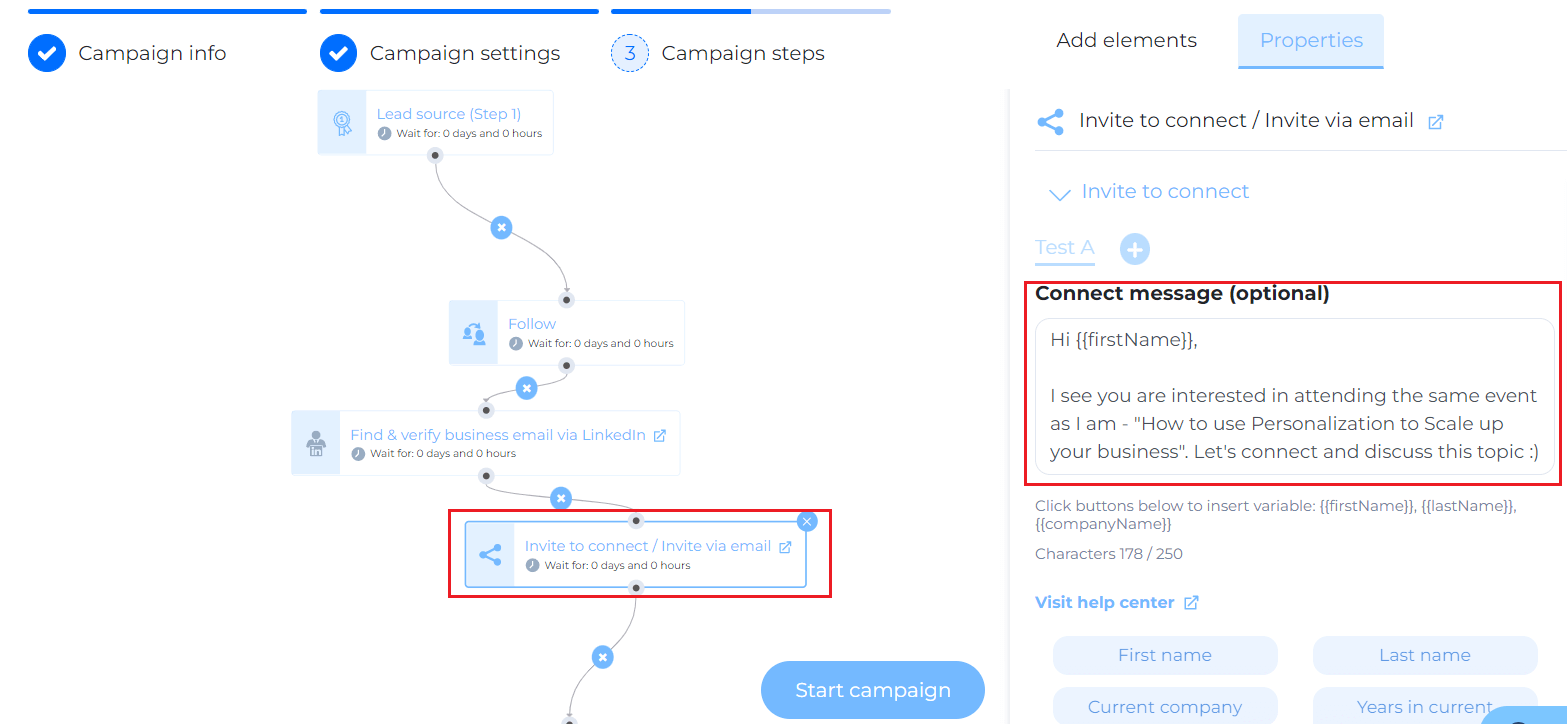
Furthermore, you’d be surprised to hear that Skylead not only sends connection invites but continues to outreach your target audience and perform other actions for you. For example, if the person accepted the invite and didn’t respond to your message, you can instruct Skylead to send a follow-up.
On the other hand, if, after a couple of days, the person doesn't accept the invite, you can check if Skylead found their email address and send them an email to multichannel your outreach.
All you need to do on your end is to determine the steps in the Smart Sequence, and Skylead will do it for you.
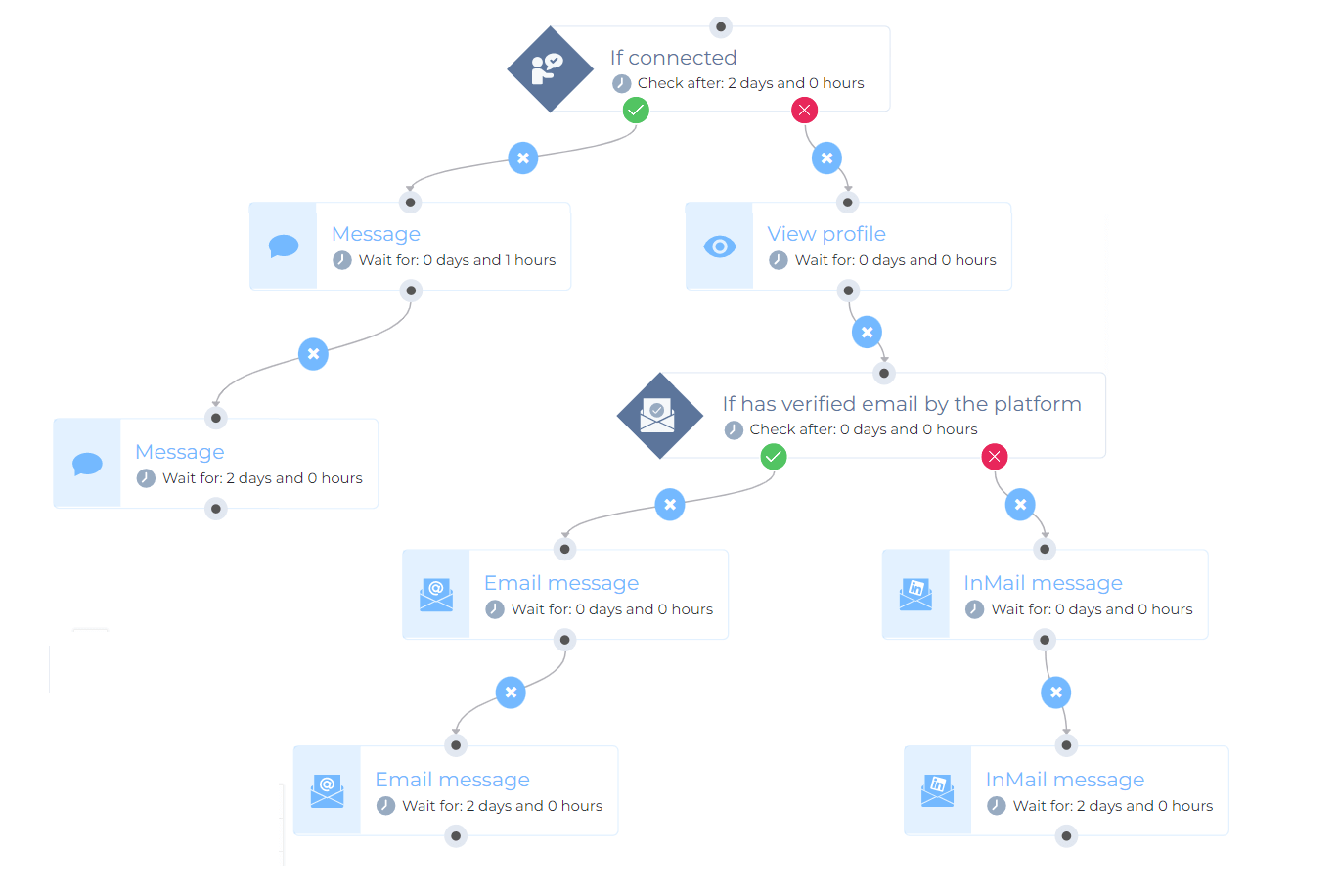
Once you set all the sequence steps, click Start Campaign, and Skylead will start to outreach your audience.
In conclusion
There are many ways you can add a person to your LinkedIn network. However, there are only 3 ways to maintain and create a strong network: politeness, honesty, and consistency in building relationships. So, to sum up…
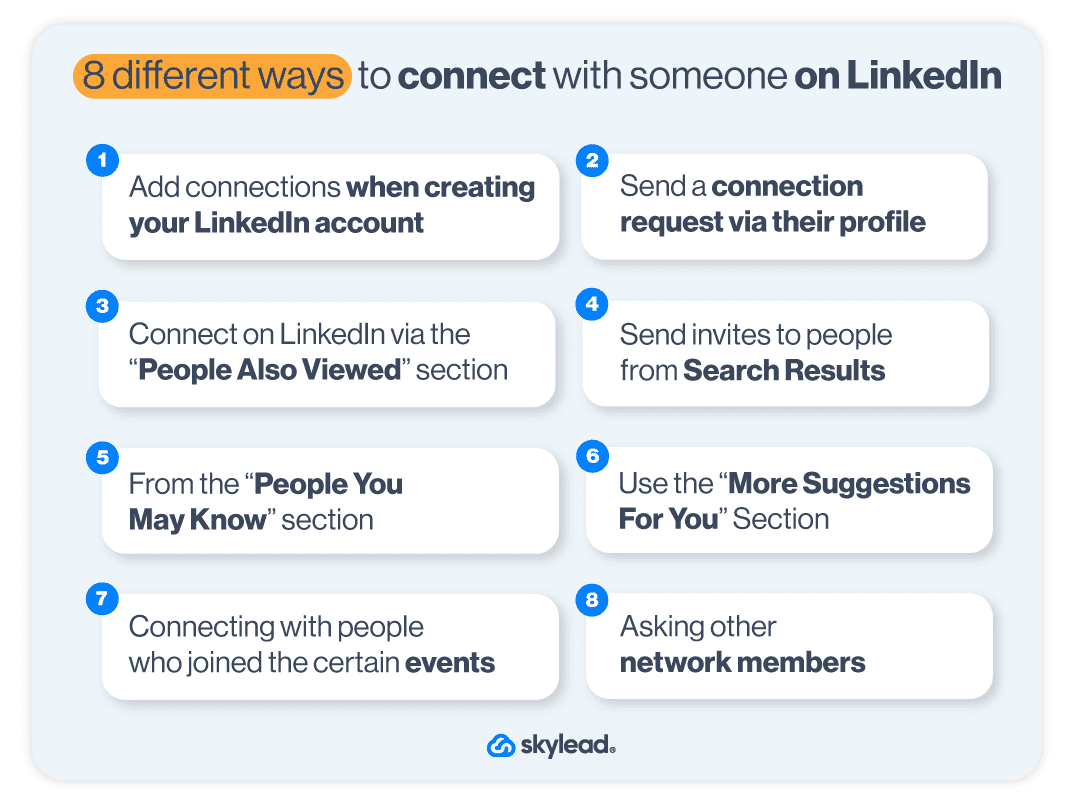
And don’t forget about the top things to do before adding someone to your network:
- Set up your LinkedIn profile;
- Craft your message carefully;
- Prepare to engage;
- Connect with someone you know first.
And if you find yourself with no time to build your network, or you simply wish to find a solution that will do it all for you, then try out Skylead, a sales engagement tool that thinks for you.
See Skylead in action! Start your 7-day Free Trial now.
